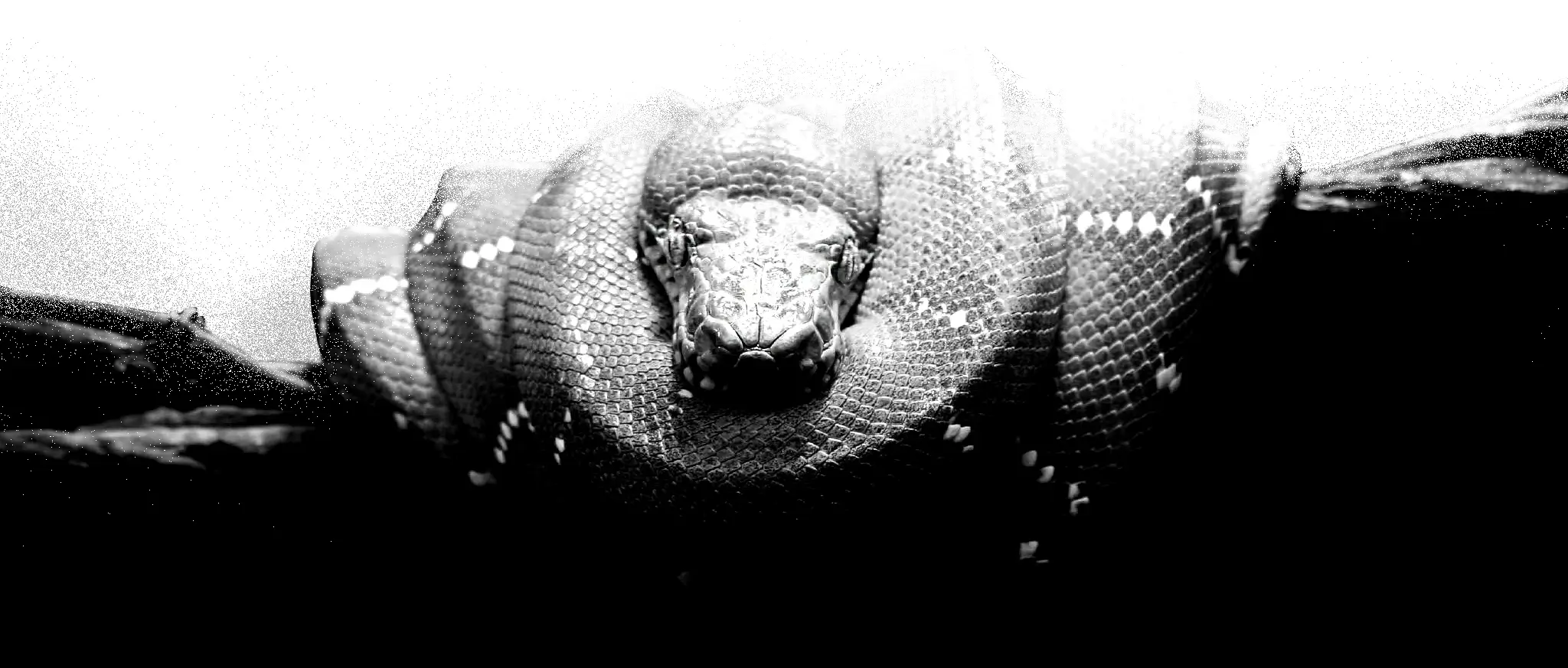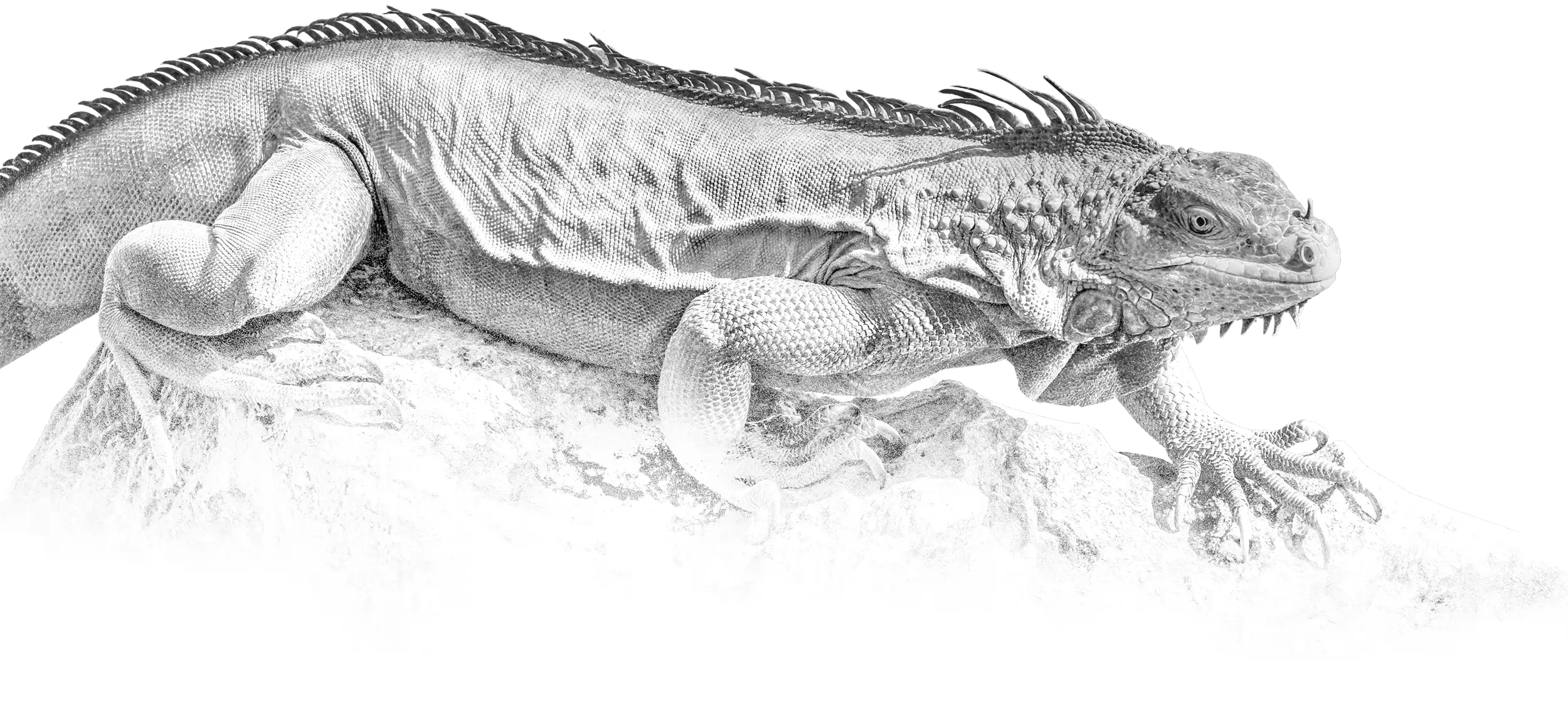
(Typhlopidae)
Typical Blind Snakes
Сліпуни
The Typhlopidae are a family of blind snakes. They are found mostly in the tropical regions of Africa, Asia, the Americas, and all mainland Australia and various islands. The rostral scale overhangs the mouth to form a shovel-like burrowing structure. They live underground in burrows, and since they have no use for vision, their eyes are mostly vestigial. They have light-detecting black eye spots, and teeth occur in the upper jaw. Typhlopids do not have dislocatable lower jaw articulations restricting them to prey smaller than their oral aperture. All species in the family Typhlopidae are fossorial and feed on social fossorial invertebrates such as termites, ants, and their larvae and eggs. The tracheal lung is present and chambered in all species. One species, the Brahminy’s blind snake, is the only unisexual snake, with the entire population being female and reproducing via parthenogenesis. The tail ends with a horn-like scale. Most of these species are oviparous. Currently, 18 genera are recognized containing over 200 species.
Description
The total length of most species ranges from 7 to 28 cm, with maximum recorded sizes reaching 97 cm. The snout is distinctly protruding, and the head shields are specialized for a burrowing lifestyle. The skull is dense and compact, with reduced kinesis compared to more evolutionarily advanced snakes. The mouth is positioned on the ventral surface of the head. In some species, the eye region is externally indistinguishable.
The body shows clear adaptations to a fossorial life. The body covered with smooth, rounded scales. Dorsal and ventral scales are of equal size. The tail is very short and thick, ending in a sharp spine. The strongly reduced eyes are visible only as dark spots beneath the thick horny shields.
The premaxillary and maxillary bones do not make contact. The premaxillary, palatine, and mandibular bones lack teeth, while the maxillary bones bear a few small teeth at their posteroinferior ends. The nasal bones are broadly connected with the frontal and prefrontal bones. Supratemporal bones are absent.
All genera retain vestiges of the pelvis, and in some species rudimentary hindlimbs are also present.
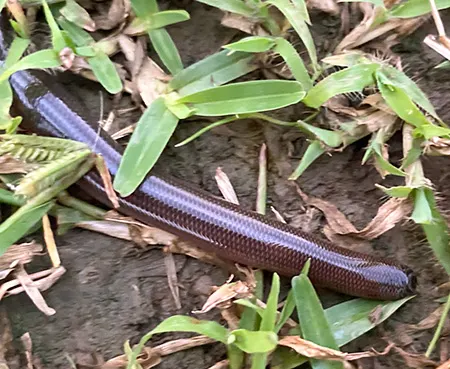
(Afrotyphlops angolensis)
Angola Blind Snake
Сліпун ангольський
It is widespread in Central and East Africa. It occurs in a variety of habitats, including Afromontane forest, lowland tropical moist forest, grassland mosaic, and bushland.
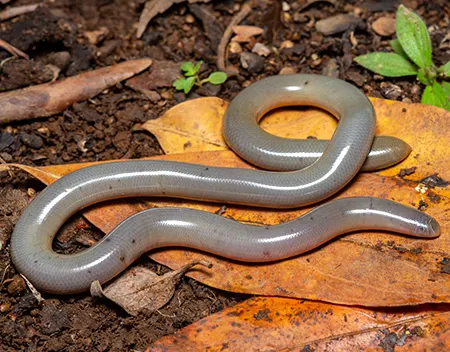
(Afrotyphlops bibronii)
Bibron's Blind Snake
Сліпун Біброна
It is found in extreme southeastern Botswana, eastern and northern South Africa, Lesotho, Eswatini, and eastern Zimbabwe, and possibly Mozambique. It inhabits coastal grasslands and the Highveld, at elevations of up to 2,000 m.
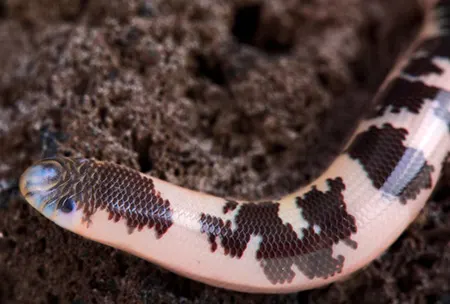
(Afrotyphlops congestus)
Blotched Blind Snake
It is distributed from eastern Nigeria through much of Middle Africa to Uganda. It occurs in humid forests, and particularly in the east, in gallery forests.
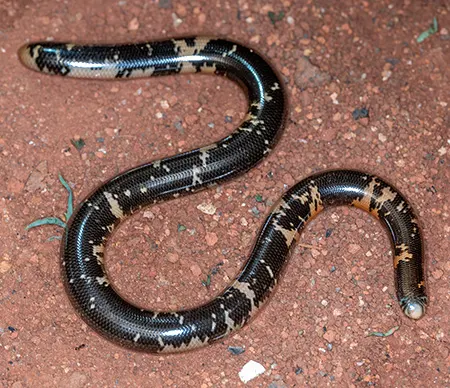
(Afrotyphlops dinga)
Zambezi Blind Snake
Сліпун замбезійський
It is found along the coast of Kenya, in southern Democratic Republic of the Congo, Tanzania, Angola, Zambia, Zimbabwe, Malawi, Mozambique, eastern Namibia, Botswana, and north-eastern South Africa. It inhabits savannas, woodlands, and miombo.
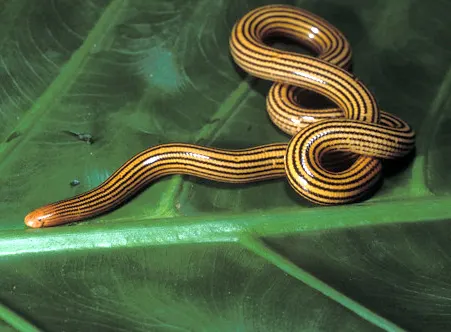
(Afrotyphlops elegans)
Elegant Worm Snake
Сліпун елегантний
It occurs on the island of Príncipe in São Tomé and Príncipe. It inhabits primary and secondary tropical rainforests at elevations of 10–400 m.
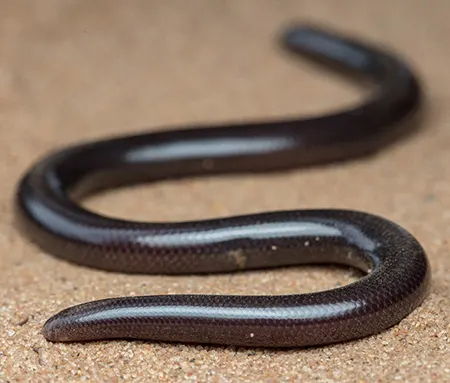
(Afrotyphlops fornasinii)
Fornasini's Blind Snake
Сліпун Форнасіні
It is found in southern Mozambique, South Africa (Zululand), and southeastern Zimbabwe. It prefers grasslands and coastal bush. It is also found in shrubland and savanna up to an altitude of 450 m.
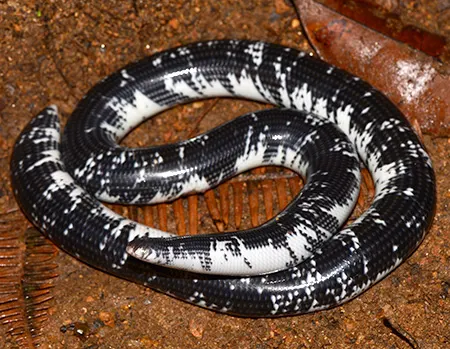
(Afrotyphlops liberiensis)
Liberian Blind Snake
Сліпун ліберійський
It is found in southern Guinea, Sierra Leone, Liberia, Côte d’Ivoire, and south-western Ghana. It inhabits humid tropical forests and also occurs in secondary and gallery forests within savannas.
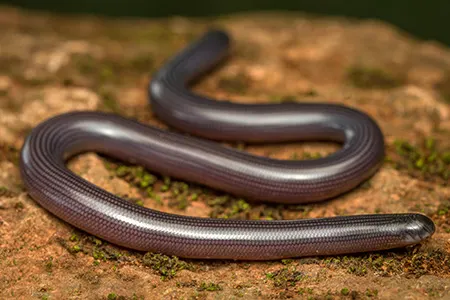
(Afrotyphlops lineolatus)
Common Lined Worm Snake
Сліпун смугастий
It is widely distributed in Sub-Saharan Africa, from Senegal in the west to Ethiopia in the east and Angola and Zambia in the south.
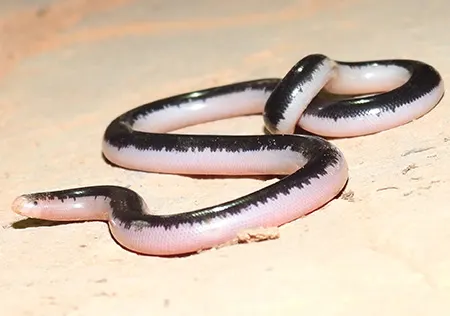
(Afrotyphlops nigrocandidus)
Bicoloured blind snake
Сліпун двоколірний
It is endemic to east–central Tanzania. It inhabits montane tropical forests at elevations of 1,450–1,750 m.
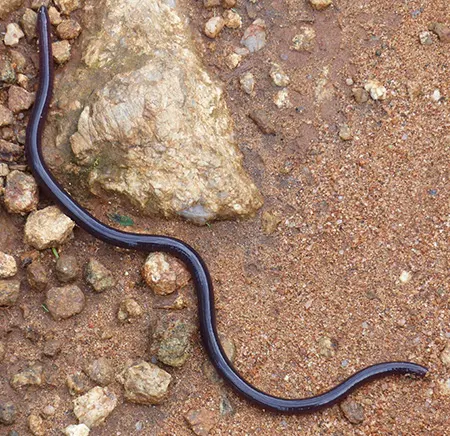
(Afrotyphlops obtusus)
Slender Blind Snake
Сліпун стрункий
It is found in southern Malawi, northern Mozambique, and eastern Zimbabwe. It inhabits coastal, gallery and montane forest, Miombo woodland, and even in urban compost heaps.
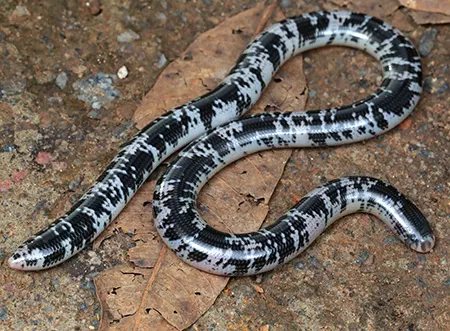
(Afrotyphlops punctatus)
Spotted Blind Snake
Сліпун плямистий
It is distributed from Senegal to South Sudan, north-eastern DR Congo, and Uganda. It inhabits humid savannas and woodlands, among fallen leaves and brushwood.
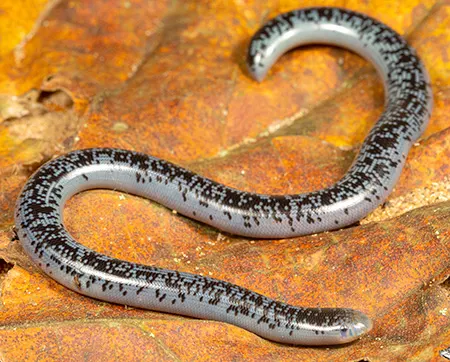
(Afrotyphlops schlegelii)
Schlegel’s Beaked Blind Snake
Сліпун Шлегеля
It is found in Angola, Botswana, the Democratic Republic of the Congo, Eswatini, Ethiopia, Kenya, Malawi, southern Mozambique, northern Namibia, Somalia, South Africa, southern Sudan, Tanzania, northern Uganda, Zambia, and Zimbabwe.
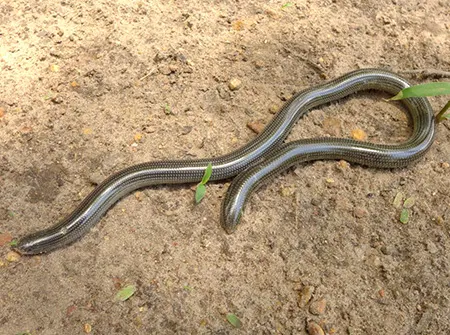
(Afrotyphlops schmidti)
Schmidt’s Blind-Snake
Сліпун Шмідта
It is found in Angola, Zambia, and eastern and southern Democratic Republic of the Congo. It inhabits savannas.
(Afrotyphlops)
Afrotyphlops is a genus of snakes in the family Typhlopidae. They are found in sub-Saharan Africa.
Usambara Blind-Snake (Afrotyphlops usambaricus), Liwale Blind-Snake (Afrotyphlops tanganicanus), Steinhaus’ Worm Snake (Afrotyphlops steinhausi), (Afrotyphlops rouxestevae), Rondo Worm Snake (Afrotyphlops rondoensis), Tanga Worm Snake (Afrotyphlops platyrhynchus), Kenyan Dwarf Blind-Snake (Afrotyphlops nanus), Kakamega Blind-Snake (Afrotyphlops kaimosae), Gierra’s Blind Snake (Afrotyphlops gierrai), Wedgenose Worm Snake (Afrotyphlops cuneirostris), Chirio’s Blind Snake (Afrotyphlops chirioi), Calabresi’s Blind-Snake (Afrotyphlops calabresii), Somali Giant Blind-Snake (Afrotyphlops brevis), Blanfords Blind-Snake (Afrotyphlops blanfordii), Angolan Giant Blind-Snake (Afrotyphlops anomalus).
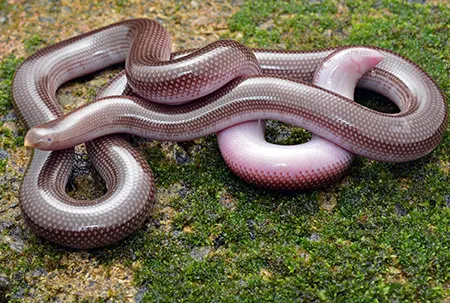
(Grypotyphlops acutus)
Beaked Worm Snake
Сліпун дзьобоносий
It is found throughout peninsular India south of the Ganges and Rajputana basins. It inhabits humid and dry tropical forests, in secondary thickets and on plantations, at elevations of 10–700 m.
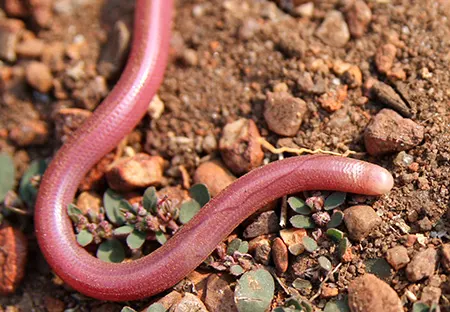
(Letheobia akagerae)
Akagera Gracile Blind Snake
Сліпун акагерський
It is endemic to Rwanda. It is found in Akagera National Park near the shores of Lake Igema, at an elevation of 1,290 m. It inhabits gallery forests and savannas.
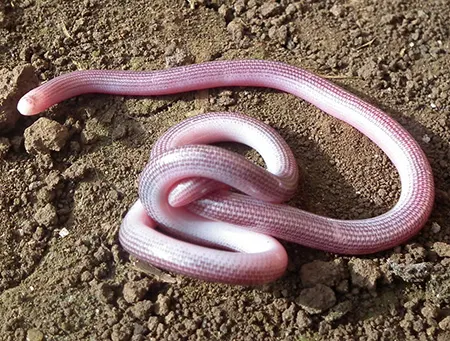
(Letheobia decorosus)
Cameroon Gracile Blind-Snake
Сліпун камерунський
It is found in Cameroon and the Central African Republic. It inhabits humid tropical forests and savannas at elevations of 10–1,175 m.
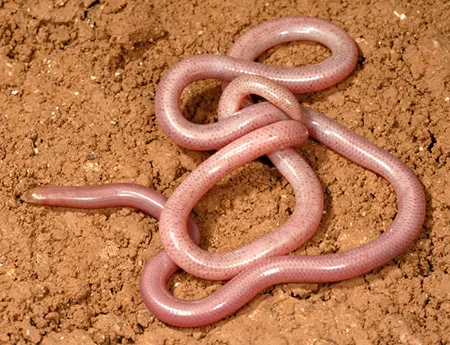
(Letheobia episcopus)
It is known from several localities in southern Turkey and north-eastern Syria. They live in grasslands, woodlands, and scrub.
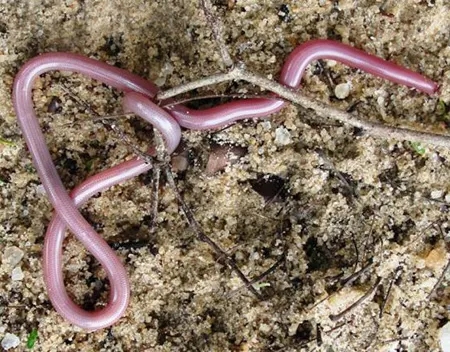
(Letheobia lumbriciformis)
Wormlike Beaked Snake
Сліпун дзьобоносий червеподібний
It is found in coastal areas of southeastern Kenya and northeastern Tanzania, as well as on Unguja Island in the Zanzibar Archipelago. It inhabits coastal savannas, plantations, and gardens.
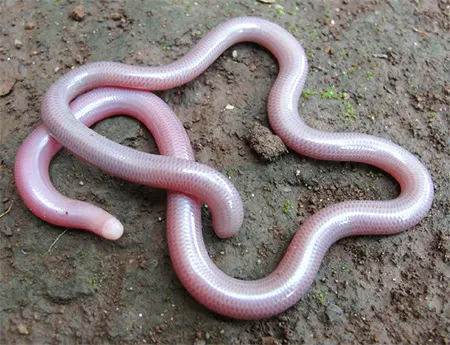
(Letheobia mbeerensis)
Mbeere gracile blind snake
It is known from the type specimen collected near Siakago in central Kenya, at an elevation of 1,221 m.
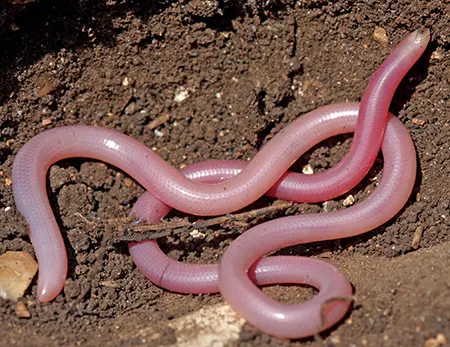
(Letheobia simoni)
Israeli Worm Snake
Сліпун ізраїльський
It is found in Israel, Jordan, and Syria. It prefers subtropical or tropical dry shrubland and Mediterranean-type shrubby vegetation.
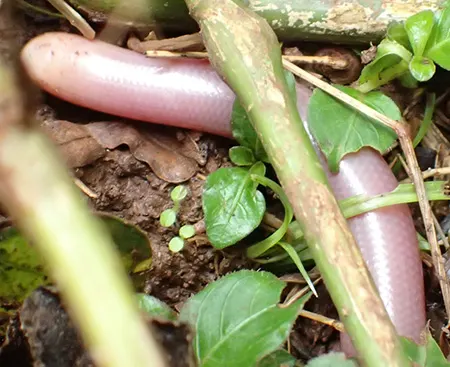
(Letheobia somalica)
Ethiopian Blind Snake
Сліпун ефіопський
It is endemic to Ethiopia. It is found in grasslands, forests, and savannas, and also occurs in fields and human settlements, at altitudes of 1,800–2,200 m.
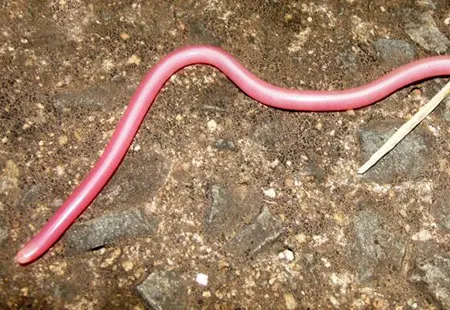
(Letheobia swahilica)
Swahili Gracile Blind-Snake
Сліпун суахільський стрункий
It is found in coastal areas of south-eastern Kenya and north-eastern Tanzania. It inhabits coastal forests, fields, and orchards at an elevation of up to 400 m.
(Letheobia)
It is a genus of blind snakes in the family Typhlopidae. They live in Africa and the Middle East.
Zenker’s Worm Snake (Letheobia zenkeri), De Witte’s Gracile Blind-Snake (Letheobia wittei), Weidholz’s Pink Blindsnake (Letheobia weidholzi), Uluguri Worm Snake (Letheobia uluguruensis), Torit Gracile Blind-Snake (Letheobia toritensis), Garamba Gracile Blind-Snake (Letheobia sudanensis), Stejneger’s Beaked Snake (Letheobia stejnegeri), Haut-Oubangui Beaked Snake (Letheobia rufescens), Léopoldville Beaked Snake (Letheobia praeocularis), Pemba Gracile Blind-Snake (Letheobia pembana), (Letheobia pauwelsi), Zanzibar Beaked Snake (Letheobia pallida), Newton’s Beaked Snake (Letheobia newtoni), Mann’s Worm Snake (Letheobia manni), Liberia Worm Snake (Letheobia leucosticta), Largen’s Blind-Snake (Letheobia largeni), Katanga Beaked Snake (Letheobia kibarae), (Letheobia jubana), Lake Tanganyika Blind Snake (Letheobia graueri), Gracile Blind-Snake (Letheobia gracilis), St. Thomas Beaked Snake (Letheobia feae), Eritrean Blind Snake (Letheobia erythraea), Feeble Gracile Blind-Snake (Letheobia debilis), Cross’ Beaked Snake (Letheobia crossii), (Letheobia coecatus), Gabon Beaked Snake (Letheobia caeca), Mann’s Worm Snake (Letheobia angeli), (Letheobia acutirostrata).
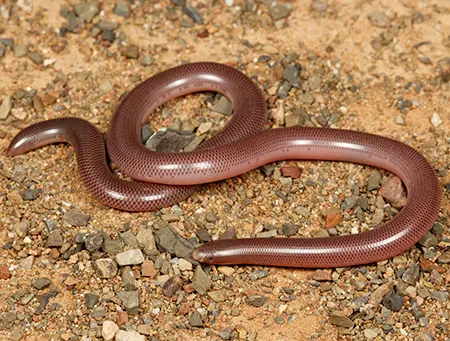
(Rhinotyphlops lalandei)
Delalande's Beaked Blind Snake
Сліпун Делаланда
It occurs throughout the eastern half of Southern Africa, as far south as Cape Town and with isolated populations in western parts such as Namibia. It can be found in a variety of habitats including semidesert, savannah, coastal bush, and fynbos, at altitudes up to 2,200 m.
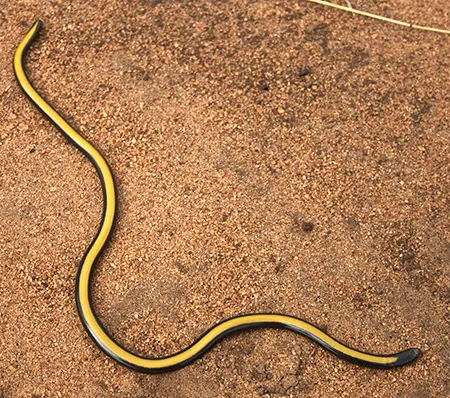
(Rhinotyphlops unitaeniatus)
Kenya Beaked Snake
Сліпун жовтосмугий
It is found in eastern Kenya, Somalia, and north-eastern Tanzania. It inhabits Acacia-Commiphora deciduous bushland and thicket, at elevations of 20–1,600 m.
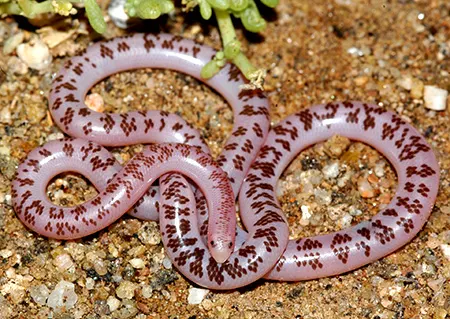
(Rhinotyphlops schinzi)
Schinz's Beaked Blind Snake
Сліпун Шинца
It is found from Namibia and neighboring Botswana south to Calvinia and Kenhardt in Northern Cape, South Africa. It inhabits dry savannas, semi-deserts and deserts at elevations of 100–1,310 m.
The genus (Rhinotyphlops) also includes: Scortecci’s Blind-Snake (Rhinotyphlops scorteccii), White-headed Beaked Snake (Rhinotyphlops leucocephalus), Boyle’s Beaked Blind Snake (Rhinotyphlops boylei), Somali Blind-Snake (Rhinotyphlops ataeniatus).
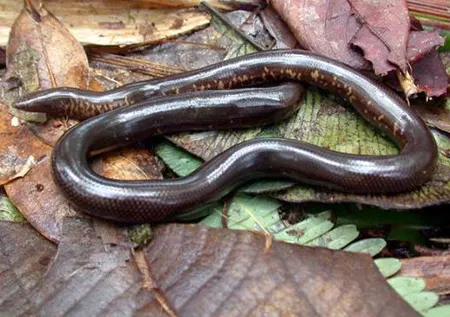
(Acutotyphlops subocularis)
Bismarck Sharp-nosed Blindsnake
Сліпун гостроносий бісмаркський
It is found on Umboi Island, New Britain, Duke of York Island, New Ireland, the Bismarck Archipelago, and the Solomon Islands. It inhabits humid tropical forests at elevations of 25–1,067 m.
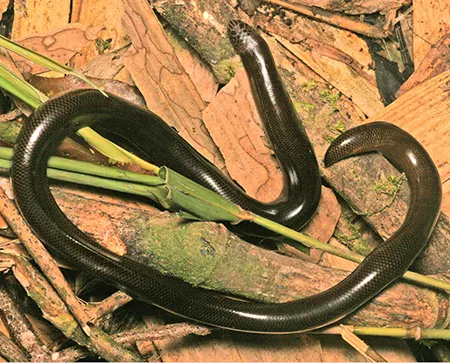
(Acutotyphlops solomonis)
It is found in eastern Papua New Guinea and on the island of Bougainville. It inhabits humid tropical forests at elevations of up to 915 m.
Kunua Blind Snake (Acutotyphlops kunuaensis), Red Blind Snake (Acutotyphlops infralabialis), Balbalan Blind Snake (Acutotyphlops banaorum).
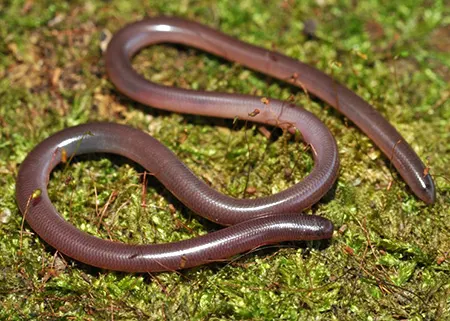
(Anilios affinis)
Small-headed Blind Snake
Сліпун малоголовий
It is widespread in eastern and south-eastern Queensland and north-eastern New South Wales. It lives in dry woodlands on red sandy soils and among sandstone outcrops.
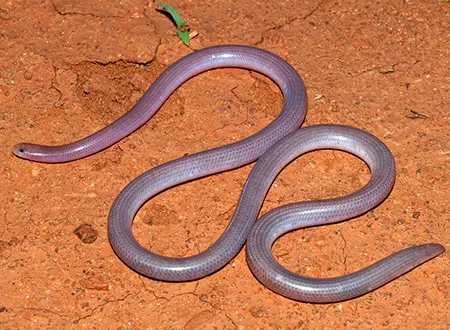
(Anilios ammodytes)
Sand-diving Blind Snake
It is found in the Pilbara region of Western Australia. The type locality is Hermite Island in the Montebello Islands off the Pilbara coast.
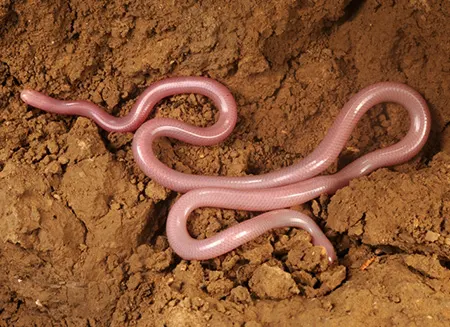
(Anilios aspina)
Round-tailed Blind Snake
Сліпун круглохвостий
It inhabits the Mitchell Grass Downs of central Queensland.
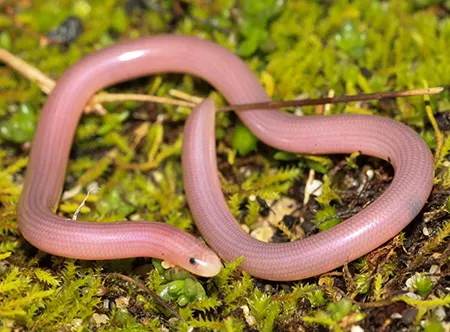
(Anilios australis)
Southern Blind Snake
Сліпун південний
It is found in south-western Western Australia, from Shark Bay to Cape Arid. It inhabits dry grasslands, scrub, and savannah.
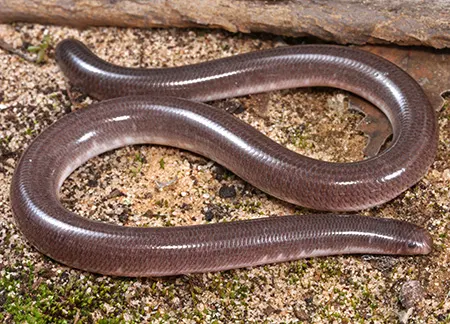
(Anilios bicolor)
Dark-spined Blind Snake
it is found in extreme south-eastern Western Australia, much of southern South Australia, western New South Wales and north-western Victoria.
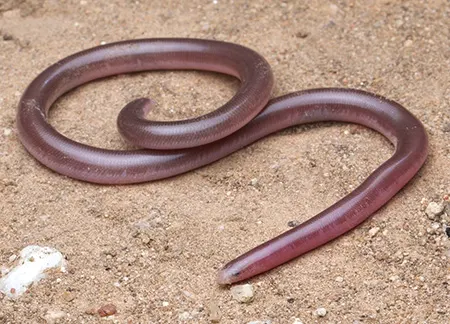
(Anilios bituberculatus)
Prong-snouted Blind Snake
It is an arid adapted species, occurring in varied habitats from coastal areas to drier parts of southern Australia, stretching across from inland NSW to WA. It is found in the states of New South Wales, Northern Territory, Queensland, South Australia, Victoria and Western Australia.
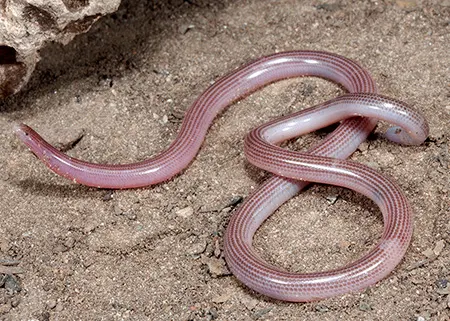
(Anilios broomi)
Faint-striped Blind Snake
Сліпун Брума
It is found in north-eastern Queensland, Australia. It inhabits woodland, mallee, and arid and semi-arid areas.
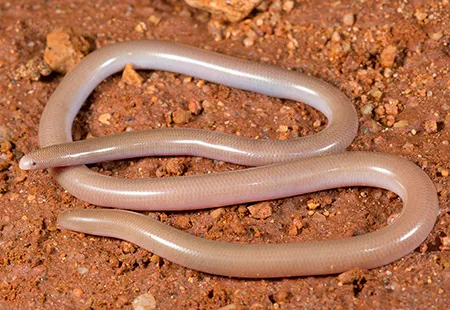
(Anilios centralis)
Centralian Blind Snake
Сліпун центральноавстралійський
It is found in central Australia, from the MacDonnell Ranges in the Northern Territory to northern South Australia. It inhabits dry scrub and woodland on rocky and loamy soils.
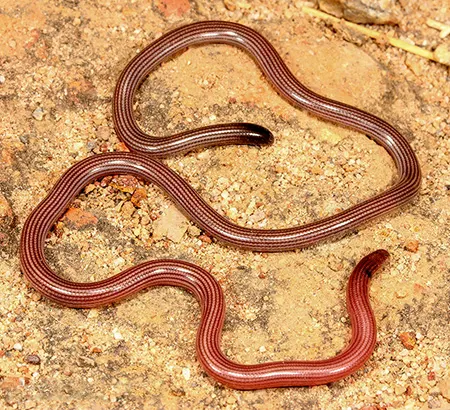
(Anilios chamodracaena)
Cape York Striped Blind Snake
Сліпун смугастий Кейп-Йоркський
It occurs in northern and western Cape York Peninsula, Queensland, Australia, where it inhabits woodlands and savannas.
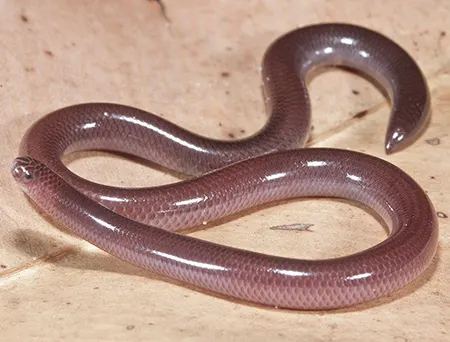
(Anilios diversus)
Northern Blind Snake
Сліпун північний
It is found in the Northern Territory, Queensland, and Western Australia. It inhabits deserts and grasslands.
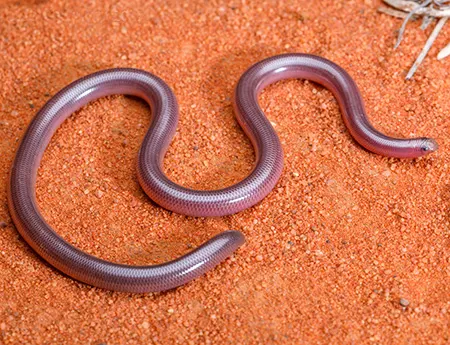
(Anilios endoterus)
Interior Blind Snake
Сліпун внутрішній
It occurs in Western Australia, the Northern Territory, South Australia, Queensland, and New South Wales. It is mostly found living in the central areas of the continent in arid and semi-arid regions.
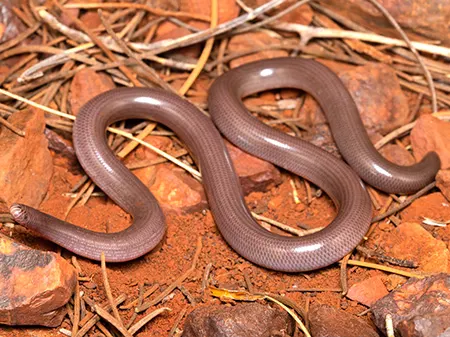
(Anilios ganei)
Gane's Blind Snake
Сліпун Гейна
It is found in the Pilbara region of north-western Western Australia. It inhabits ravines and gorges, among rocks, and in dry mulga thickets.
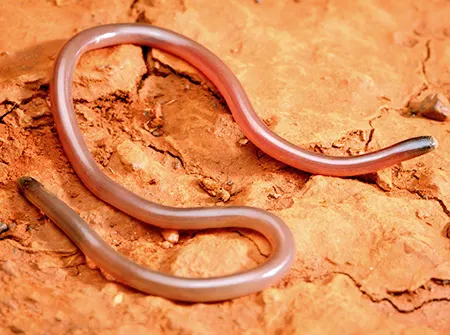
(Anilios grypus)
Long-beaked Blind Snake
Сліпун довгодзьобий
It is endemic to northern Australia (in Western Australia, the Northern Territory, and Queensland). It inhabits dry meadows, dry rocky areas, and semi-deserts.
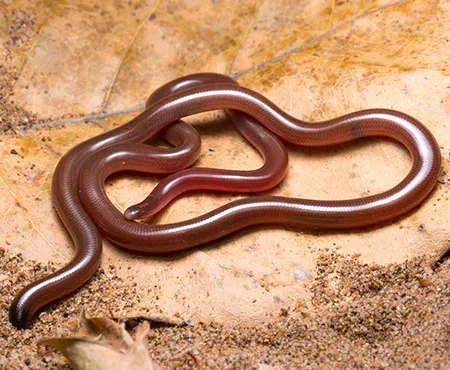
(Anilios guentheri)
Top End Blind Snake
Сліпун Гюнтера
It is found from the Kimberley region of Western Australia to the Top End of the Northern Territory. It inhabits dry grasslands growing on red soils.
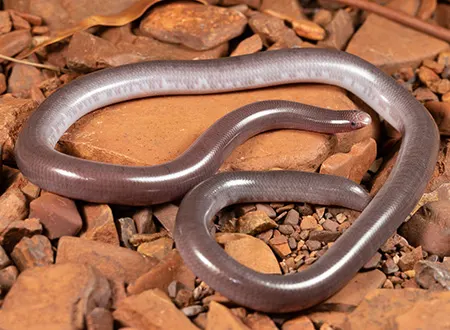
(Anilios hamatus)
Pale-headed Blind Snake
Сліпун блідоголовий
It is found in coastal and inland areas of Western Australia. It inhabits dry savannas and scrublands, including spinifex, mallee, and mulga thickets.
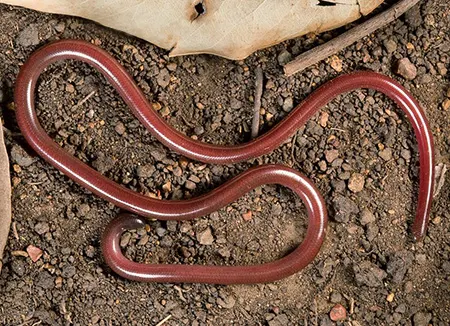
(Anilios howi)
Kimberley Deep-soil Blind Snake
Сліпун кімберлійський глибокоґрунтовий
It is found in the Australian state of Western Australia. It inhabits dry grassland.
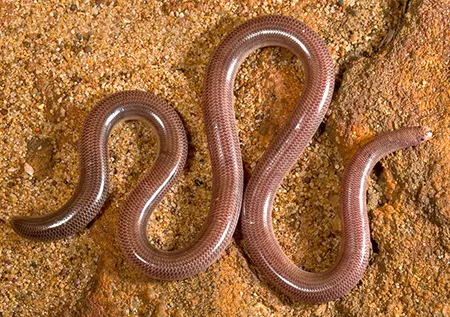
(Anilios kimberleyensis)
Kimberley Shallow-soil Blind Snake
Сліпун кімберлійський мілкоґрунтовий
It is found from the Kimberley region of Western Australia to the western Top End of the Northern Territory. It inhabits seasonally wet grasslands.
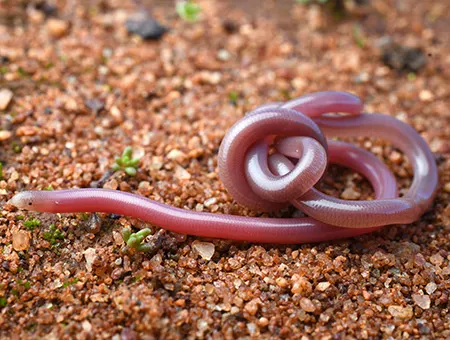
(Anilios leptosoma)
Murchison Blind Snake
Сліпун мурчісонський
It is found in the western part of Western Australia, in the Murchison River region between the Wooramel River and the city of Geraldton. It inhabits dry scrubland on sandy soils.
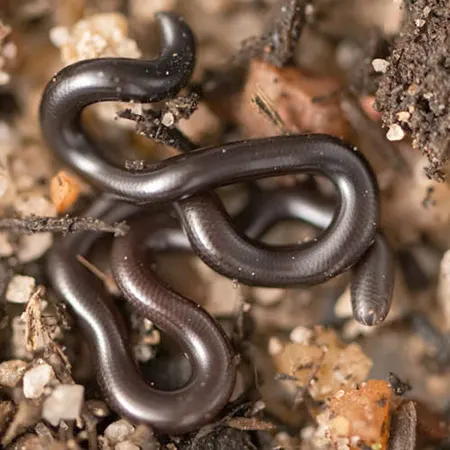
(Anilios leucoproctus)
White-tailed Blindsnake
Сліпун білохвостий
It is found in the northeast of the Cape York Peninsula in Queensland, in the eastern Torres Strait Islands, and in southern New Guinea.
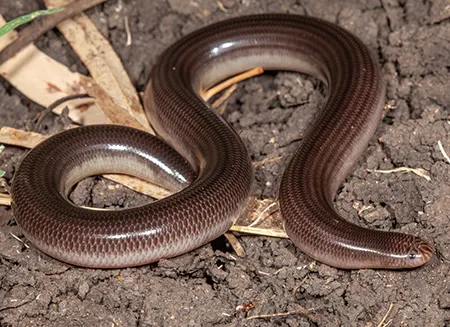
(Anilios ligatus)
Robust Blind Snake
Сліпун міцний
It is found in northern and eastern Australia, from the Kimberley region of Western Australia through the Northern Territory and Queensland to northern New South Wales. It inhabits wet and dry grasslands, savannas, woodlands, and scrub.
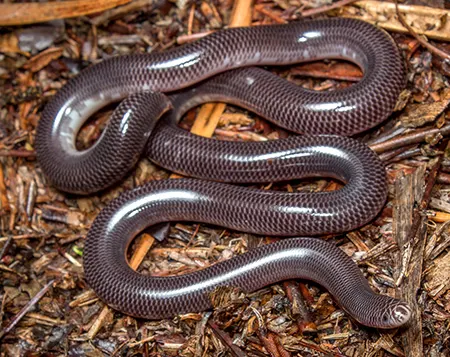
(Anilios nigrescens)
Blackish Blind Snake
Сліпун чорнуватий
It is found in south-eastern Australia, in New South Wales, Queensland, and Victoria.
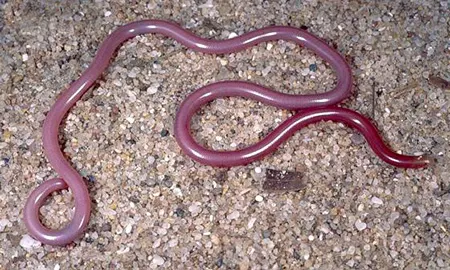
(Anilios obtusifrons)
Blunt-snouted Blind Snake
Сліпун тупоносий
It occurs in the Geraldton Sandplains bioregion of Western Australia. The habitat is typically Acacia woodland or shrubland with scattered mallee on brown loam soils.
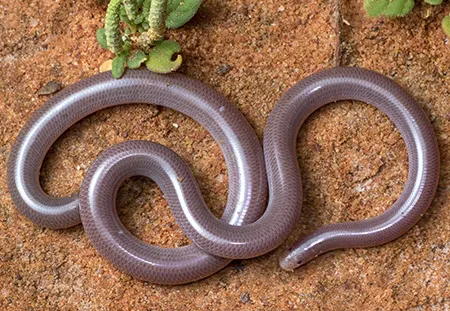
(Anilios pilbarensis)
Pilbara Blind Snake
Сліпун пілбарський
It is found in the Pilbara region of Western Australia. It inhabits rocky plains covered with scrub and spinifex thickets.
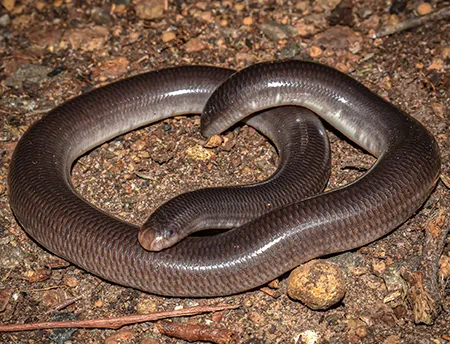
(Anilios pinguis)
Rotund Blind Snake
Сліпун товстий
It is found in south-western Western Australia.
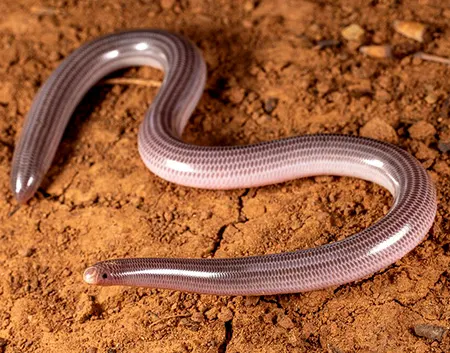
(Anilios proximus)
Woodland Blind Snake
Сліпун лісовий
It is found in eastern Queensland, New South Wales, northern Victoria and eastern South Australia. It inhabits forests, woodlands, and rocky areas.
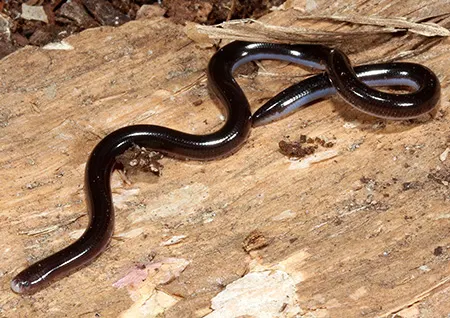
(Anilios silvia)
Great Sandy Blind Snake
Сліпун великий піщаний
It is found in the Australian state of Queensland.
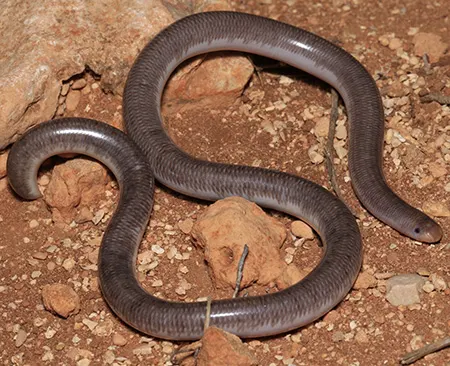
(Anilios splendidus)
Splendid Blind Snake
Сліпун чудовий
It occurs at North West Cape in the Gascoyne region of Western Australia. It inhabits shrub thickets growing on coral limestone soils.
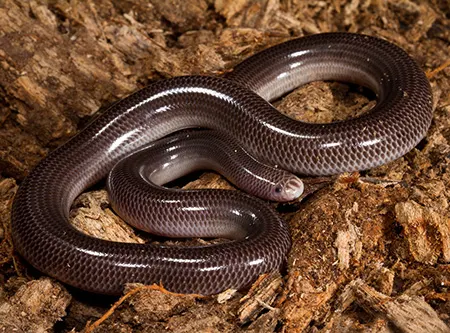
(Anilios torresianus)
North-eastern Blind Snake
Сліпун північно-східний
It occurs in southern Papua New Guinea and along the northeastern coast of Queensland, Australia, particularly in the Torres Strait region.
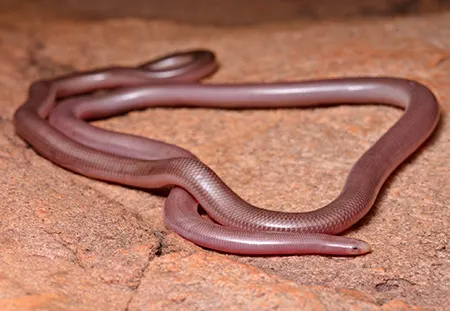
(Anilios troglodytes)
Sandamara Blind Snake
It is found in the Kimberley region of Western Australia, where it inhabits savannas and dry grasslands.
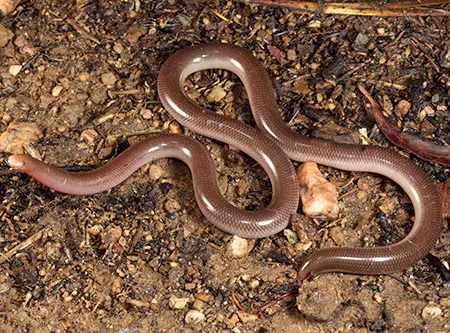
(Anilios unguirostris)
Claw-snouted Blind Snake
Сліпун кігтеносий
It is widespread in northern and eastern Australia, from Western Australia through the Northern Territory to Gladstone in Queensland. It inhabits tropical rainforests and scrub grasslands.
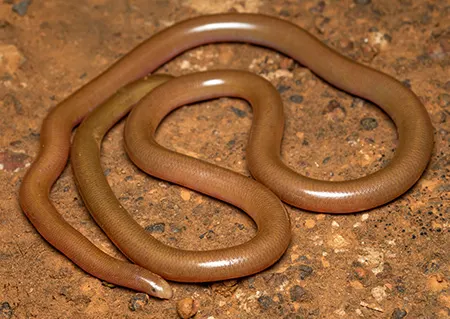
(Anilios waitii)
Beaked Blind Snake
Сліпун Вайта
It is endemic to Western Australia, where it inhabits grassland, shrubland, and savanna.
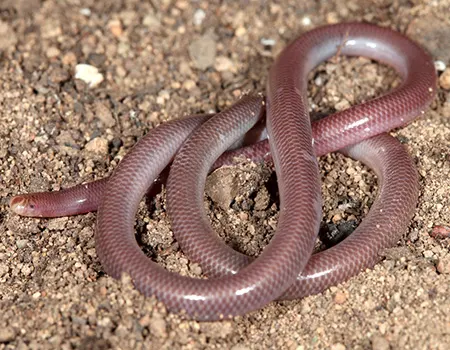
(Anilios wiedii)
Brown-snouted Blind Snake
Сліпун буромордий
It is found in the Australian states of New South Wales and Queensland. It inhabits forests and savannas.
(Anilios)
It is a genus of snakes in the family Typhlopidae. They are found predominantly in Australia, with a few species located in New Guinea.
West Kimberley Blind Snake (Anilios zonula), Yirrkala Blind Snake (Anilios yirrikalae), Yampi Blind Snake (Anilios yampiensis), Mornington Blind Snake (Anilios vagurima), Darwin Blind Snake (Anilios tovelli), Sharp-snouted Blind Snake (Anilios systenos), Roberts’ Blind Snake (Anilios robertsi), Thread-like Blind Snake (Anilios nema), Groote Eylandt Dwarf Blind Snake (Anilios minimus), Small-eyed Blind Snake (Anilios micromma), Buff-snouted Blind Snake (Anilios margaretae), Barrow Island Blind Snake (Anilios longissimus), Fassifern Blind Snake (Anilios insperatus), Hale River Blind Snake (Anilios fossor), Northern New Guinea Blindsnake (Anilios erycinus), Shovel-snouted Blind Snake (Anilios batillus).
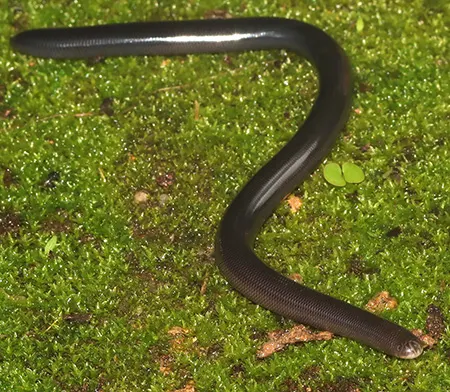
(Argyrophis diardii)
Diard's Blindsnake
Сліпун Діарда
It is found in India (Jalpaiguri, West Bengal, and as far west as the Dun Valley in Assam), Bangladesh, Myanmar, Thailand, Laos, Cambodia, Vietnam, the Malay Peninsula, Nias Island, Sumatra, Web Island (off north-western Sumatra), Bangka, and Borneo. It inhabits forests, shrublands, and grasslands, but has also been recorded in agricultural areas.
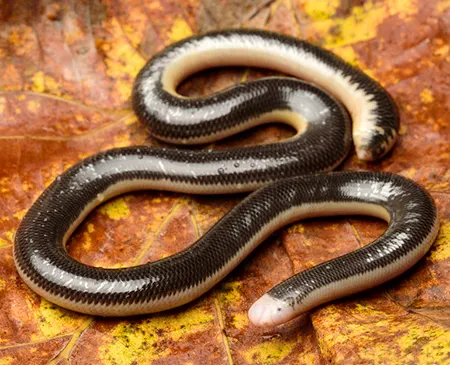
(Argyrophis muelleri)
White-bellied Blind Snake
Сліпун білочеревий
It is found in Myanmar, Thailand, Cambodia, Vietnam, West Malaysia, Singapore, and parts of Indonesia. It inhabits primary and dense secondary forests, but can also occur in gardens in rural areas. It is sometimes found in waterlogged soil, including muddy agricultural land.
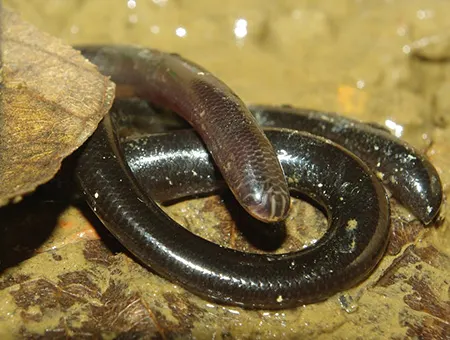
(Argyrophis siamensis)
Siamese Blind Snake
Сліпун сіамський
It is found in south-eastern Thailand, Cambodia, and southern Vietnam, where it inhabits humid lowland tropical forests.
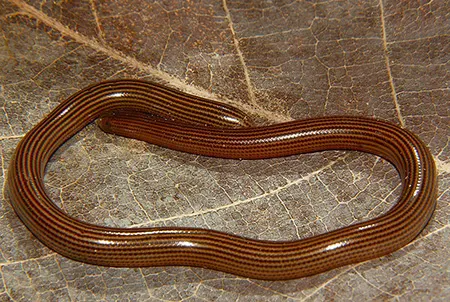
(Argyrophis oatesii)
Oate's Blind Snake
Сліпун Оутса
It is endemic to the Andaman Islands.
The genus (Argyrophis) also includes: Roxane’s Blind Snake (Argyrophis roxaneae), Trang Blind Snake (Argyrophis trangensis), Koshun Worm Snake (Argyrophis koshunensis), Klemmer’s Blind Snake (Argyrophis klemmeri), Sumatra Worm Snake (Argyrophis hypsobothrius), Vietnam Worm Snake (Argyrophis giadinhensis), Brown Worm Snake (Argyrophis fuscus), Gunther’s Blind Snake (Argyrophis bothriorhynchus).
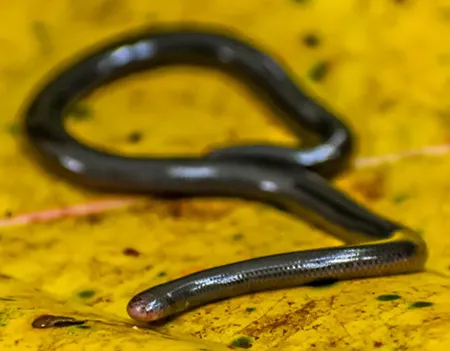
(Cyclotyphlops deharvengi)
Deharveng’s Blind Snake
Сліпун Дехарвена
It is found in south-eastern Sulawesi, Indonesia. It inhabits forests at elevations of up to 500 m.
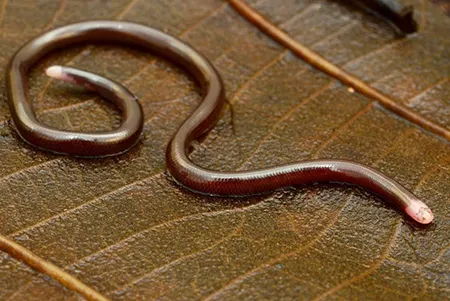
(Indotyphlops albiceps)
White-headed Blind Snake
Сліпун білоголовий
It occurs in southern Thailand, Myanmar, Laos, western Malaysia, and Hong Kong. It inhabits lowland tropical forests and gardens.
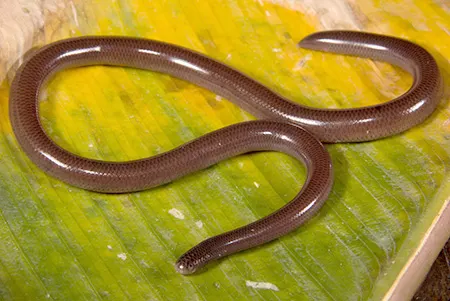
(Indotyphlops braminus)
Brahminy Blindsnake
Сліпун брамінський
It is found in India, Sri Lanka, and Southeast Asia. Along with flower pots, it has been introduced to North America, the Hawaiian Islands, South Africa, and Australia.
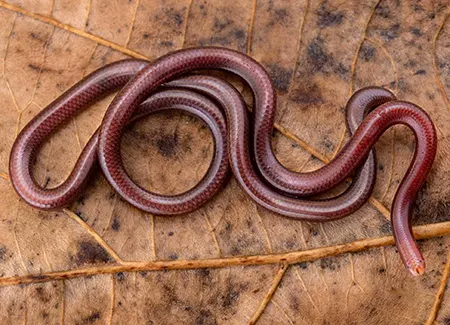
(Indotyphlops lazelli)
Hong Kong Blind Snake
Сліпун гонконгський
It is endemic to Hong Kong. It inhabits subtropical forests, at altitudes of 100–200 m.
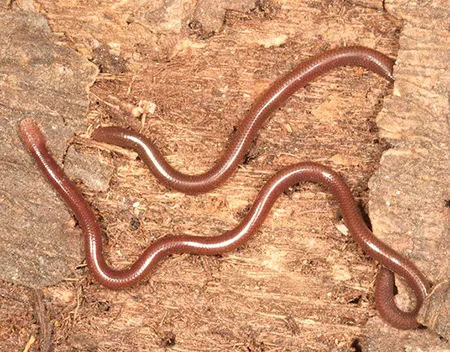
(Indotyphlops laca)
Laca's Worm Snake
It is native to Timor-Leste.
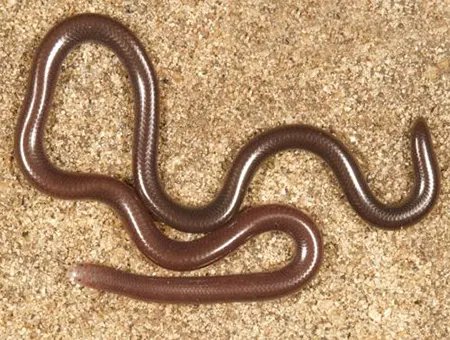
(Indotyphlops combank)
It is endemic to Sri Lanka.
(Indotyphlops)
It is a genus of snakes in the family Typhlopidae.
Violet Worm Snake (Indotyphlops violaceus), Vedda Worm Snake (Indotyphlops veddae), Peter’s Worm Snake (Indotyphlops tenuicollis), (Indotyphlops tenebrarum), Schmutz’s Worm Snake (Indotyphlops schmutzi), South Indian Blind Snake (Indotyphlops pammeces), Meszoelys Blind Snake (Indotyphlops meszoelyi), Malcolm’s Worm Snake (Indotyphlops malcolmi), (Indotyphlops madgemintonae), Loveridge’s Worm Snake (Indotyphlops loveridgei), Long Worm Snake (Indotyphlops longissimus), Pied Worm Snake (Indotyphlops leucomelas), Sri Lanka Worm Snake (Indotyphlops lankaensis), Jerdon’s Worm Snake (Indotyphlops jerdoni), (Indotyphlops fletcheri), File Worm Snake (Indotyphlops filiformis), (Indotyphlops ahsanai).
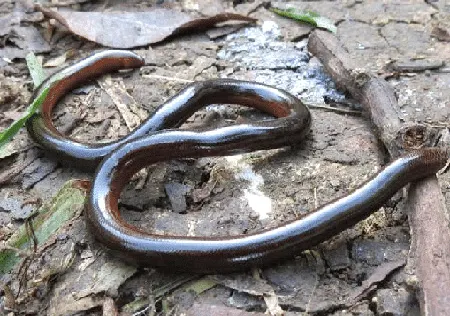
(Malayotyphlops hypogius)
Cebu Blind Snake
Сліпун цебуанський
It is endemic to the island of Cebu in the Philippines. It lives in humid tropical forests, among fallen leaves.
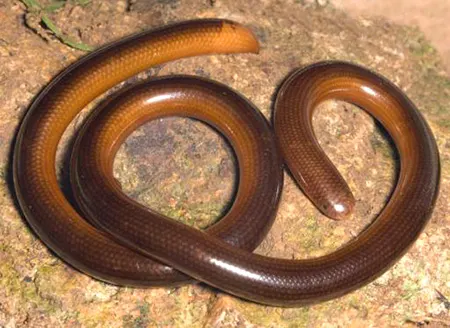
(Malayotyphlops ruficauda)
Brown Blind Snake
Сліпун коричневий
It is endemic to the Philippines, where it is found on the islands of Luzon, Tablas and Marinduque. It inhabits humid lowland and mountain tropical forests.
(Malayotyphlops)
It is a genus of non-venomous snakes in the family Typhlopidae, found in Indonesia and the Philippines.
Samar Blind Snake (Malayotyphlops ruber), Manila Blind Snake (Malayotyphlops manilae), Luzon Blind Snake (Malayotyphlops luzonensis), Kei Island Worm Snake (Malayotyphlops kraalii), Boenjoe Island Worm Snake (Malayotyphlops koekkoeki), Sierra Madre Blind Snake (Malayotyphlops denrorum), Light-collared Blind Snake (Malayotyphlops collaris), Brown-backed Blind Snake (Malayotyphlops castanotus), Taylor’s Worm Snake (Malayotyphlops canlaonensis), Andy’s Blind Snake (Malayotyphlops andyi).
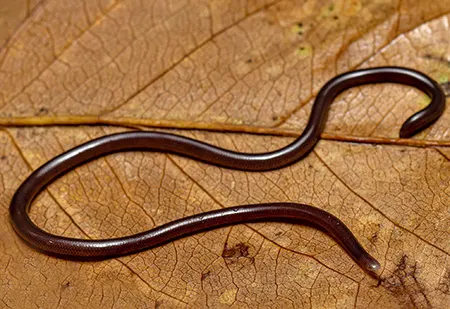
(Pseudoindotyphlops porrectus)
Slender Worm Snake
Сліпун стрункий
It is found in Pakistan, India, Nepal, Sri Lanka, northern Myanmar, Thailand, and the Sunda region.
The genus (Pseudoindotyphlops) also includes: Belgaum Worm Snake (Pseudoindotyphlops exiguus).
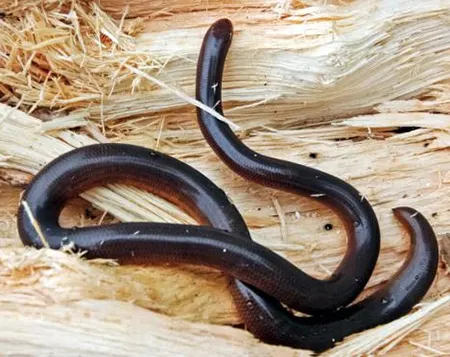
(Ramphotyphlops adocetus)
It occurs in the Caroline Islands of Micronesia, with the type locality at Pasa Island, Ant Atoll.
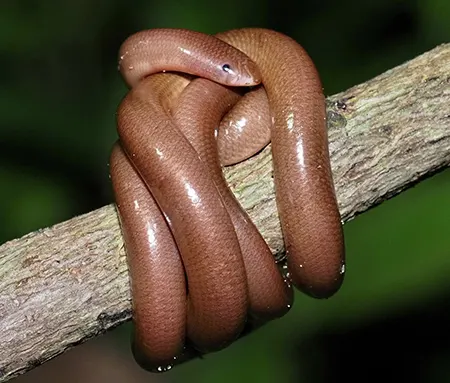
(Ramphotyphlops cumingii)
Cuming's Blind Snake
Сліпун Камінґа
It is endemic to the Philippines and is found on Bohol, Marinduque, Mindanao, Negros, Panay, and Polillo. It inhabits humid tropical forests at low and medium altitudes among epiphytic ferns.
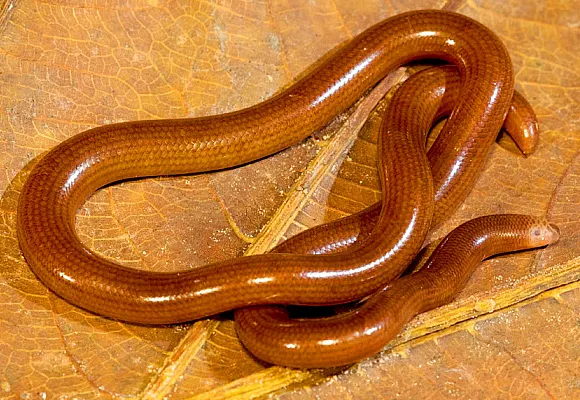
(Ramphotyphlops depressus)
Melanesia Blind Snake
Сліпун меланезійський
It is found in the Moluccas, New Guinea and neighboring islands, the Bismarck Archipelago, the Solomon Islands, and Fiji. It inhabits tropical forests, gardens, and plantations.
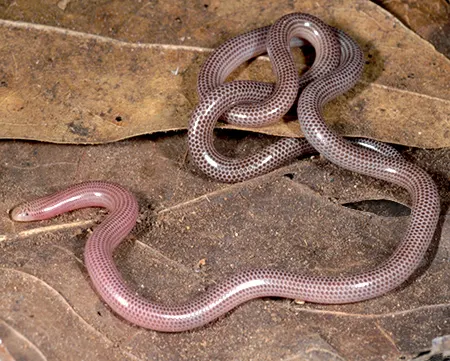
(Ramphotyphlops exocoeti)
Christmas Island Blind Snake
It is endemic to Christmas Island (Australia). It inhabits forests at altitudes up to 300 m.
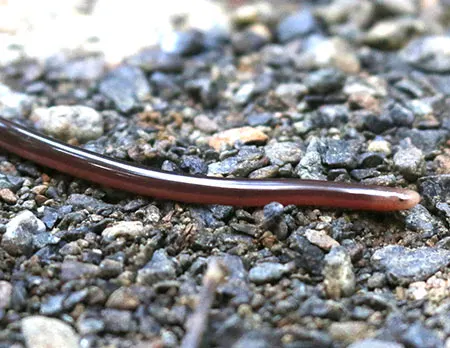
(Ramphotyphlops flaviventer)
Yellow-Bellied Blind Snake
Сліпун жовточеревий
It is known from several localities in western New Guinea, on the Doberai and Bomberai peninsulas, as well as on the neighboring islands of Batanta and Salawati.
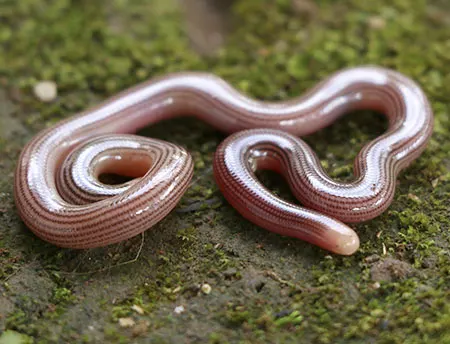
(Ramphotyphlops lineatus)
Striped Blind Snake
Сліпун смугастий
It is found on the Malay Peninsula (south of the Kra Isthmus), Sumatra, Kalimantan, Java, and neighboring islands. It inhabits lowland and montane humid tropical forests at elevations of up to 1,420 m.
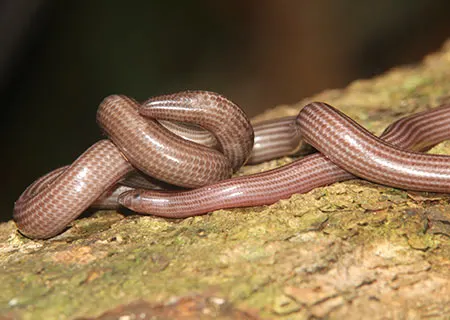
(Ramphotyphlops multilineatus)
Hook-nosed Blind Snake
Сліпун гачконосий
It is found in western New Guinea, particularly on the Doberai Peninsula, as well as on the neighboring island of Salawati and the Kai Islands.
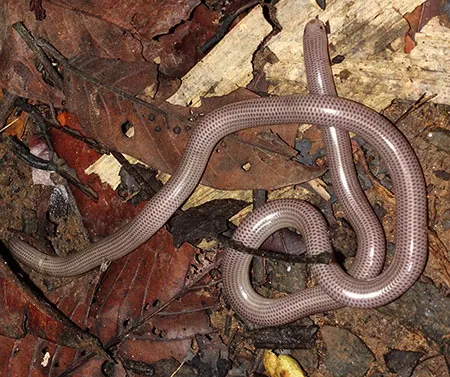
(Ramphotyphlops olivaceus)
Olive Blind Snake
Сліпун оливковий
It is found in the Philippines (Samar and Basilan islands, as well as Bubuan and Sibutu islands in the Sulu Archipelago), in Kalimantan, and on the Indonesian islands of Seram, Ambon, Misool, and Sangihe. It inhabits lowland rainforests and plantations.
(Ramphotyphlops)
Long-tailed Blind Snakes
Сліпуни довгохвості
It is a genus of nonvenomous blind snakes. Are native to southern Asia and southeast Asia, as well as many islands in the southern Pacific Ocean.
Salawati Blind Snake (Ramphotyphlops supranasalis), Loyalty Islands Blind Snake (Ramphotyphlops willeyi), Sulu Islands Worm Snake (Ramphotyphlops suluensis), Manukwari Blind Snake (Ramphotyphlops similis), Molly Ozaki’s Blind Snake (Ramphotyphlops mollyozakiae), Marx’s Worm Snake (Ramphotyphlops marxi), Small-headed Blind Snake (Ramphotyphlops mansuetus), Lorenz’s Blind Snake (Ramphotyphlops lorenzi), (Ramphotyphlops hatmaliyeb), Conrad’s Worm Snake (Ramphotyphlops conradi), Southern New Guinea Blind Snake (Ramphotyphlops bipartitus), Beck’s Blind Snake (Ramphotyphlops becki), Arboreal Blind Snake (Ramphotyphlops angusticeps), Palau Island Blind Snake (Ramphotyphlops acuticaudus), (Ramphotyphlops erebus).
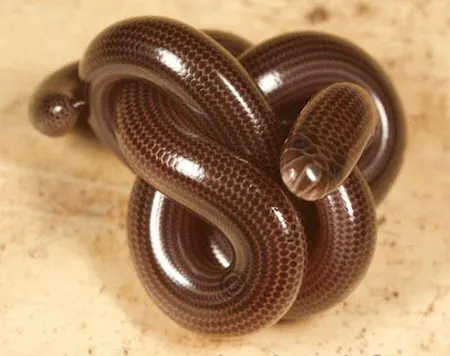
(Sundatyphlops polygrammicus)
Lesser Sunda Blind Snake
Сліпун сундський
It is found on the islands of Sumba, Lombok, Flores, Timor, Sumbawa, Komodo, Nusa Penida, and Moyo in the Lesser Sunda Islands archipelago. It inhabits dry and humid tropical forests at elevations of up to 1,200 m.
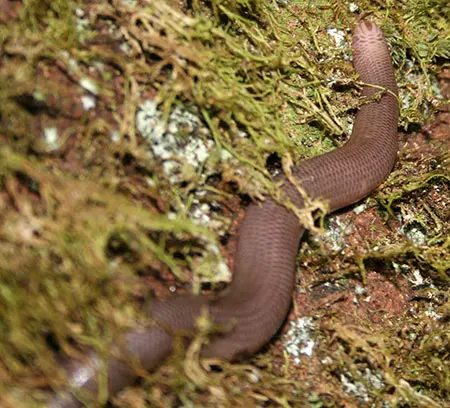
(Madatyphlops andasibensis)
Andasibe Blind Snake
It is known from its type locality in the Andasibe region in eastern Madagascar. It inhabits humid tropical forests at an altitude of 900 m.
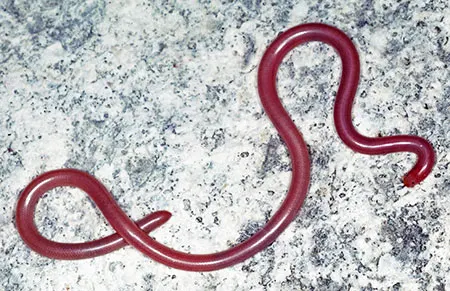
(Madatyphlops arenarius)
Sand Worm Snake
Сліпун піщаний
It is known from several localities in western and southern Madagascar. It inhabits dry tropical forests, degraded scrub, and sand dunes, at altitudes of up to 400 m.
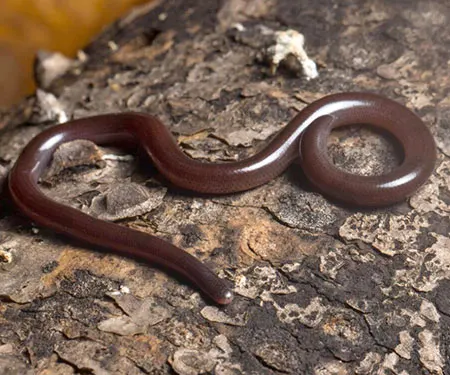
(Madatyphlops decorsei)
Mocquard's Worm Snake
It is endemic to Madagascar. It inhabits dry tropical forests at elevations of up to 1,300 m.
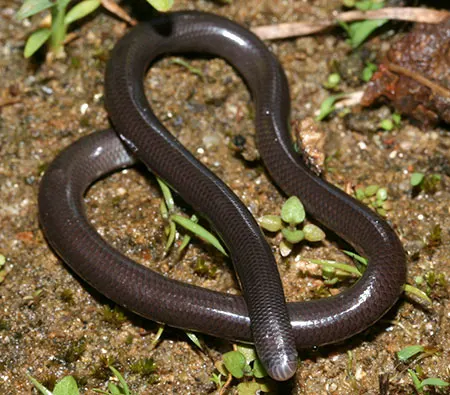
(Madatyphlops domerguei)
Domergue's Sand Worm Snake
Сліпун Домерга
It is found in southeastern Madagascar.
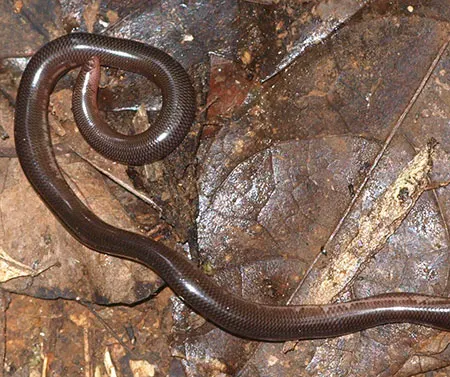
(Madatyphlops eudelini)
Eudeline's worm snake
Сліпун Евделіна
It is endemic to Mayotte Island in the Comoros Archipelago. It has only been found in the humid forest near the peak of Mt. Benara.
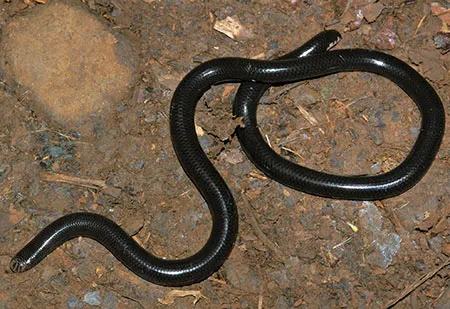
(Madatyphlops microcephalus)
It is found in northern Madagascar, particularly in the Montagne d’Ambre and Montagne des Français reserves.
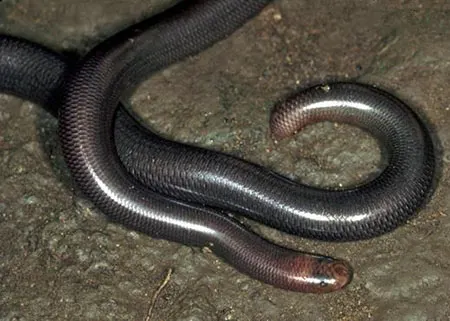
(Madatyphlops mucronatus)
Boettger's Worm Snake
Сліпун Бойттгера
It is endemic to Madagascar. It inhabits moist and dry tropical forests.
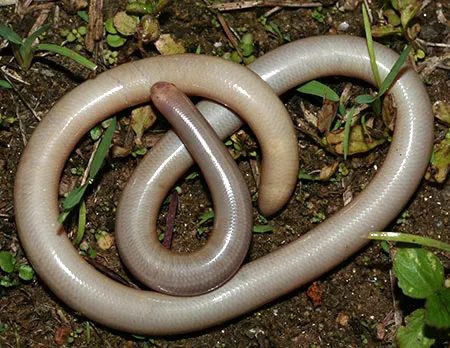
(Madatyphlops rajeryi)
It is known from its type locality in a national park in eastern Madagascar, at an altitude of 918 m. It inhabits humid tropical forests, living among fallen leaves.
The genus (Madatyphlops) also includes: Parker’s Worm Snake (Madatyphlops ocularis), Reuters Blind Snake (Madatyphlops reuteri), Madagascar Worm Snake (Madatyphlops madagascariensis), Comoro Worm Snake (Madatyphlops comorensis), (Madatyphlops boettgeri), (Madatyphlops albanalis).
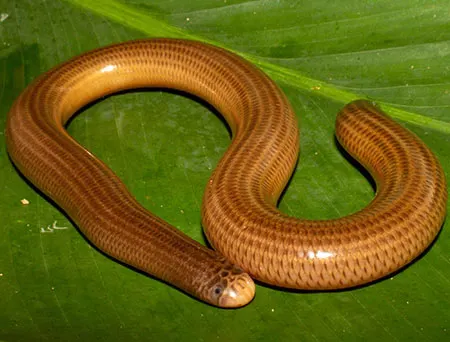
(Amerotyphlops brongersmianus)
Brongersma's Worm Snake
Сліпун Бронгерсми
It is found in Colombia, Peru, Bolivia, Brazil, Paraguay, Argentina, Venezuela, Guyana, and Suriname, as well as on the island of Trinidad. It inhabits tropical forests and savannas.
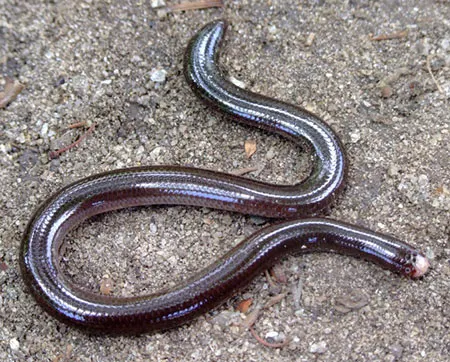
(Amerotyphlops arenensis)
It is found in the Brazilian states of Paraíba and Pernambuco, where it inhabits tropical forests.
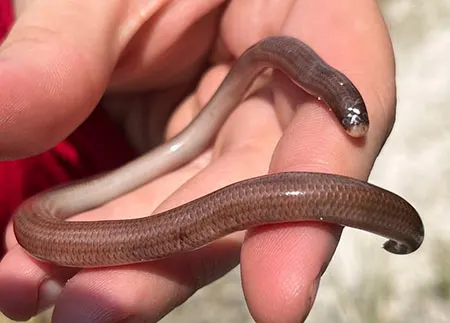
(Amerotyphlops amoipira)
It is found in the Brazilian states of Bahia, Minas Gerais, Alagoas, and Sergipe, where it inhabits dry tropical forests and caatinga scrub.
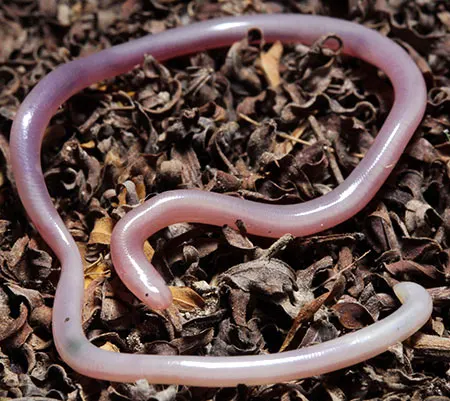
(Amerotyphlops microstomus)
Yucatecan Worm Snake
Сліпун юкатанський
It is found in the Mexican states of Yucatán, Campeche, and Quintana Roo, as well as in the northern Guatemalan department of Petén and northern Belize. It inhabits dry and humid tropical forests at elevations of up to 200 m.
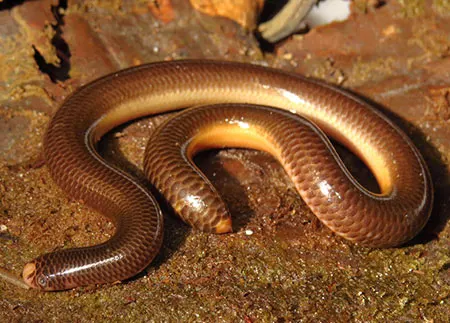
(Amerotyphlops minuisquamus)
Basin Worm Snake
It is found in Colombia, Peru, Brazil (Amazonas), and Guyana. It inhabits humid tropical forests and is also found in gardens.
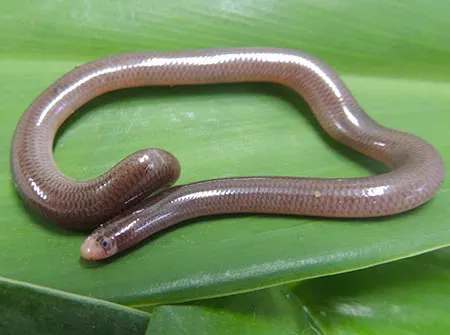
(Amerotyphlops paucisquamus)
Pernambuco Worm Snake
Сліпун пернамбуцький
It is found in the Brazilian states of Alagoas, Ceará, Maranhão, Pernambuco, Rio Grande do Norte, and Paraíba. It inhabits humid lowland tropical forests and is also found on plantations.
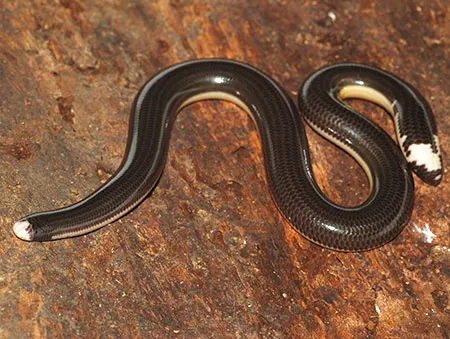
(Amerotyphlops reticulatus)
Reticulate Worm Snake
Сліпун сітчастий
It is found in Colombia, Peru, Bolivia, Brazil, the Guyanas, and Venezuela. It inhabits tropical forests, in savannahs.
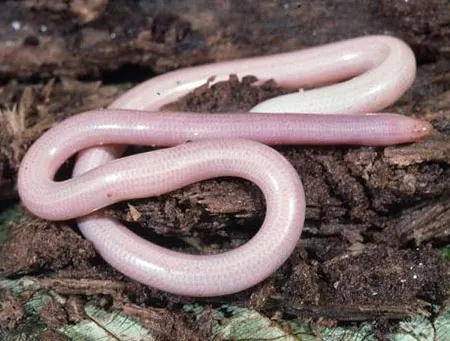
(Amerotyphlops stadelmani)
Stadelman's Worm Snake
Сліпун Стадельмана
It is found in the mountains of Honduras, where it inhabits tropical forests at elevations of 320–1,370 m.
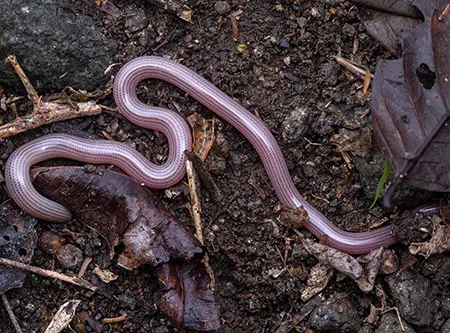
(Amerotyphlops tasymicris)
Grenada Worm Snake
Сліпун гренадський
It is endemic to Grenada, an island in the Caribbean Lesser Antilles. It inhabits dry tropical forests, among fallen leaves and rocks, and is also found on plantations.
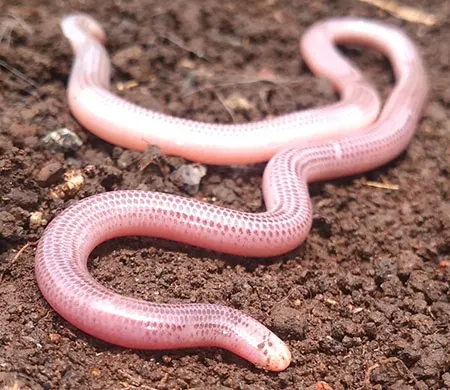
(Amerotyphlops tenuis)
Coffee Worm Snake
Сліпун кавовий
It is found from Mexico (Veracruz) south to Guatemala (Alta and Baja Verapaz). It occurs in moist forests, degraded forests, and agricultural land at elevations of up to 800 m.
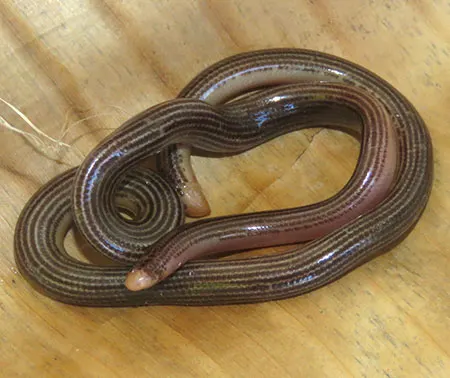
(Amerotyphlops trinitatus)
Trinidad Worm Snake
Сліпун тринідадський
It is endemic to Trinidad and Tobago. Its natural habitat consists of moist lowland tropical forests and forest edges, at elevations of 10–300 m.
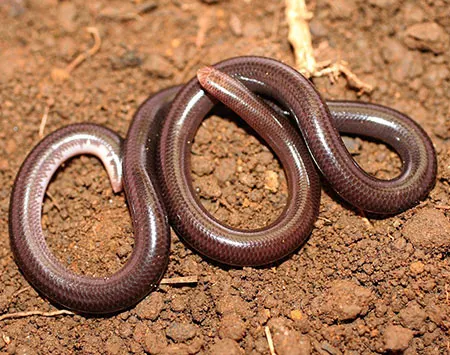
(Amerotyphlops tycherus)
Honduras Worm Snake
Сліпун гондураський
It is known from its type locality in Montaña de Santa Bárbara National Park, in the Santa Bárbara Department of western Honduras, at an elevation of 1,550 m.
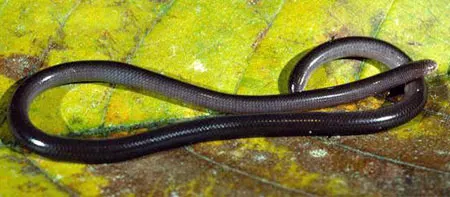
(Amerotyphlops costaricensis)
Costa Rica Worm Snake
Сліпун коста-риканський
It is found in Honduras, Nicaragua, and Costa Rica. It inhabits pine-oak forests and humid montane rainforests at elevations of 150–1,500 m.
The genus (Antillotyphlops) also includes: Yonenga Worm Snake (Amerotyphlops yonenagae), (Amerotyphlops montanum), (Amerotyphlops martis), Estado Falcon Worm Snake (Amerotyphlops lehneri), (Amerotyphlops illusorium), (Amerotyphlops caetanoi).
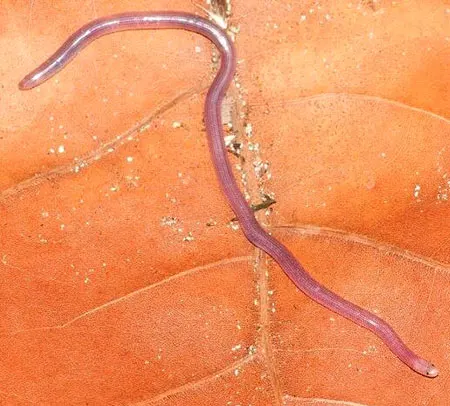
(Antillotyphlops annae)
Saint Barts Blindsnake
It is endemic to the Caribbean island of Saint Barthélemy.
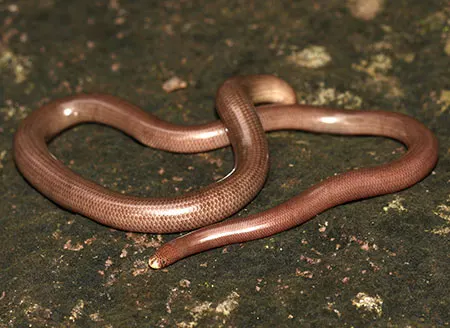
(Antillotyphlops dominicanus)
Dominican Worm Snake
Сліпун домініканський
It is endemic to the Caribbean island-nation of Dominica, in the Lesser Antilles. It is widespread, mainly in coastal xeric woodland and associated cultivated lands.
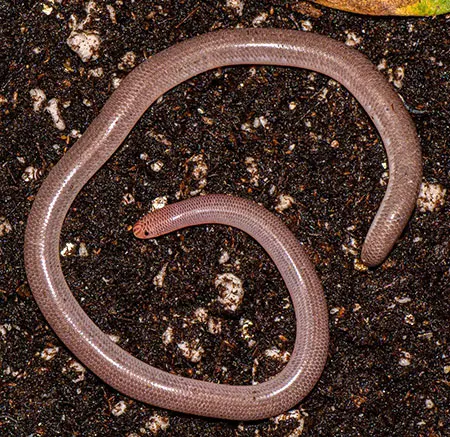
(Antillotyphlops geotomus)
Leeward Blindsnake
It is native to several islands in the Lesser Antilles, including Antigua, Barbuda, St. Kitts, Nevis, and St. Eustatius. It inhabits dry tropical forests and scrublands, and is found near human settlements.
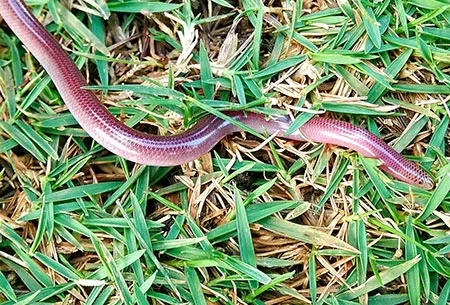
(Antillotyphlops hypomethes)
Puerto Rican Coastal Blindsnake
Сліпун пуерториканський прибережний
It is found on the north, east, and southeast coasts of Puerto Rico, as well as on the neighboring islands of Isla Palomino, Isla Piñeros, and Vieques. It inhabits coastal moist and dry tropical forests and is also found in plantations, orchards, and near human settlements, at elevations of up to 450 m.
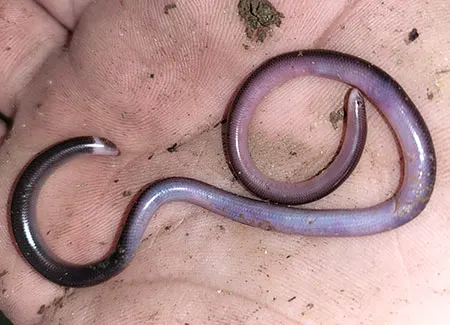
(Antillotyphlops platycephalus)
Puerto Rican White-tailed Blindsnake
Сліпун пуерториканський білохвостий
It is endemic to the Caribbean, where it is found on Anegada in the British Virgin Islands, on the Turks and Caicos Islands, and on the United States Virgin Islands.
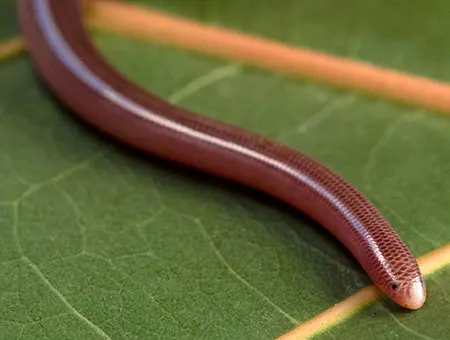
(Antillotyphlops monensis)
Mona Blind Snake
It is endemic to Mona Island in the West Indies. It inhabits coastal forests and casuarina plantations at elevations of up to 80 m.
The genus (Antillotyphlops) also includes: Richard’s Worm Snake (Antillotyphlops richardii), Erica’s Worm Snake (Antillotyphlops naugus), Montserrat Worm Snake (Antillotyphlops monastus), Guadeloupe Worm Snake (Antillotyphlops guadeloupensis), Grant’s Worm Snake (Antillotyphlops granti), Brown-backed Blind Snake (Antillotyphlops catapontus).

(Cubatyphlops biminiensis)
Bahaman Slender Blindsnake
Сліпун багамський стрункий
It is endemic to the Bahamas. It inhabits dry forests and shrubbery.
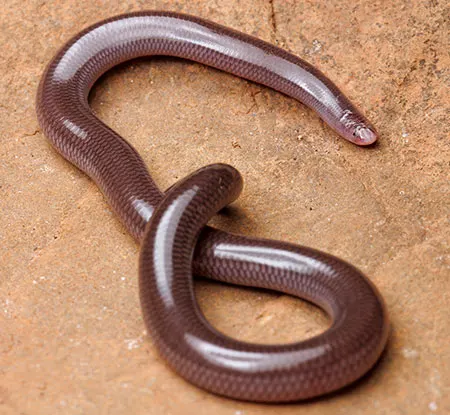
(Cubatyphlops golyathi)
Goliath Blindsnake
Сліпун-голіаф
It was discovered in the Viñales region of Pinar del Río Province, Cuba. It inhabits dry tropical forests.
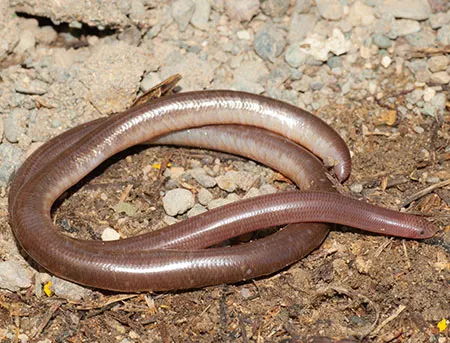
(Cubatyphlops perimychus)
Guantanamo Bay Blindsnake
Сліпун гуантанамський
It was collected at Blue Beach, within the U.S. Naval Base at Guantánamo Bay, Cuba. It inhabits dry coastal scrub.
The genus (Cubatyphlops) also includes: Cienfuegos Blindsnake (Cubatyphlops satelles). (Cubatyphlops paradoxus), Imias Blindsnake (Cubatyphlops notorachius), Cayman Brac Blindsnake (Cubatyphlops epactius), Cuban Short-nosed Blindsnake (Cubatyphlops contorhinus), Cayman Worm Snake (Cubatyphlops caymanensis), Cuban Giant Blindsnake (Cubatyphlops arator), Cuban Pallid Blindsnake (Cubatyphlops anousius), Maisi Blindsnake (Cubatyphlops anchaurus).
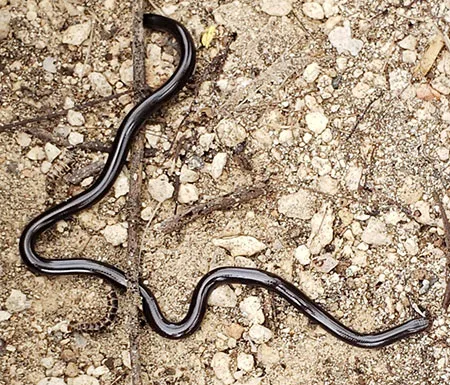
(Typhlops jamaicensis)
Jamaica Worm Snake
Сліпун ямайський
It is a small, non-venomous snake endemic to Jamaica.
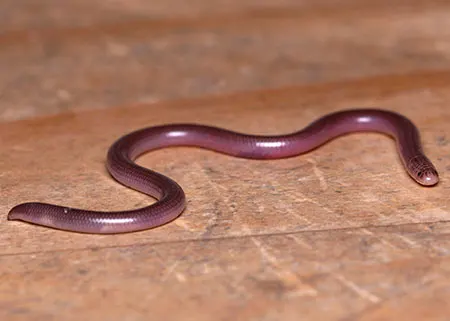
(Typhlops lumbricalis)
Earthworm Blind Snake
Сліпун багамський
It is endemic to the northern and central Bahamas. It typically lives in subterranean environments, usually in moist soil, leaf litter, and decomposing wood.
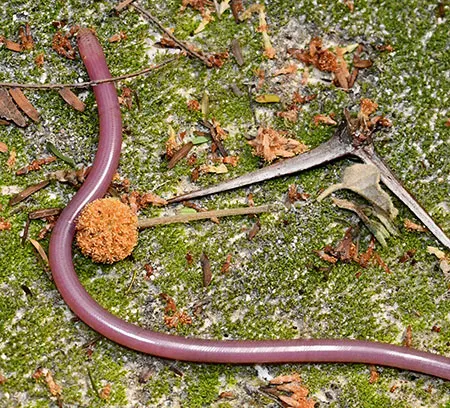
(Typhlops sulcatus)
Island Worm Snake
Сліпун острівний
It is endemic to southwestern Hispaniola (Dominican Republic and Haiti), formerly including Navassa Island, an uninhabited island located in the Caribbean.
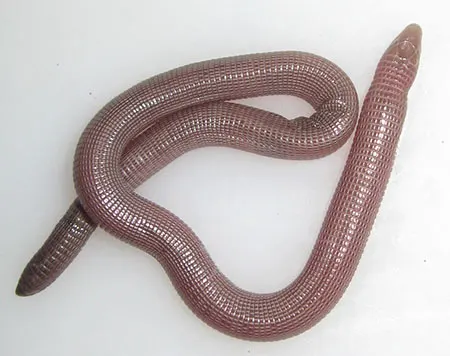
(Typhlops schwartzi)
Schwartz' Worm Snake
Сліпун Шварца
It is endemic to the Dominican Republic.
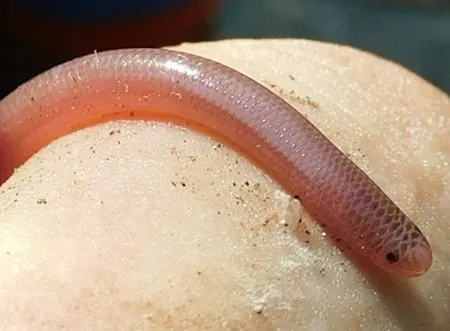
(Typhlops pusillus)
Hispaniola Worm Snake
Сліпун гаїтянський
It is endemic to the Caribbean island of Hispaniola.
The genus (Typhlops) also includes: Barahona Peninsula Blindsnake (Typhlops syntherus), Haitian Worm Snake (Typhlops tetrathyreus), Titan Worm Snake (Typhlops titanops), Pestel Blindsnake (Typhlops sylleptor), (Typhlops silus), Puerto Rican Worm Snake (Typhlops rostellatus), La Selle Blindsnake (Typhlops proancylops), (Typhlops pachyrhinus), (Typhlops oxyrhinus), (Typhlops leptolepis), Tiburon Peninsula Blindsnake (Typhlops hectus), Gonave Island Worm Snake (Typhlops gonavensis), Bahoruco Blindsnake (Typhlops eperopeus), Haitian Pale-Lipped Blindsnake (Typhlops capitulatus), La Hotte Blindsnake (Typhlops agoralionis).
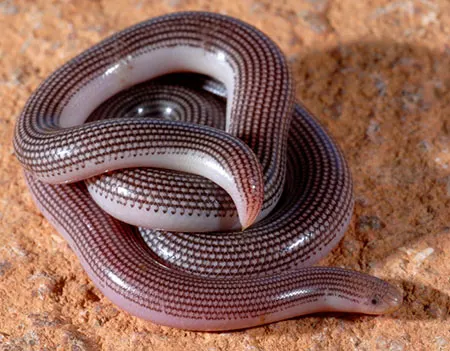
(Xerotyphlops socotranus)
Socotra Worm Snake
Сліпун сокотранський
It is found only on the island of Socotra in Yemen. It inhabits rocky highlands covered with dry shrubs and palm groves, at elevations of 30–550 m.
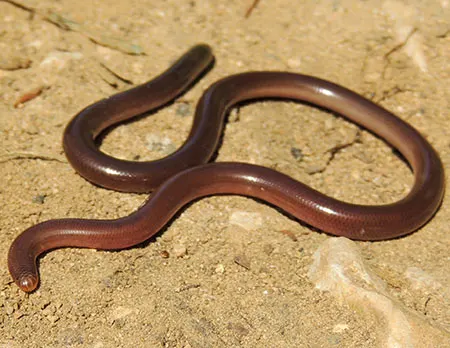
(Xerotyphlops syriacus)
Syrian Blind Snake
Сліпун сирійський
It is found in Lebanon, Syria, Jordan, the State of Palestine, Israel, and Egypt.
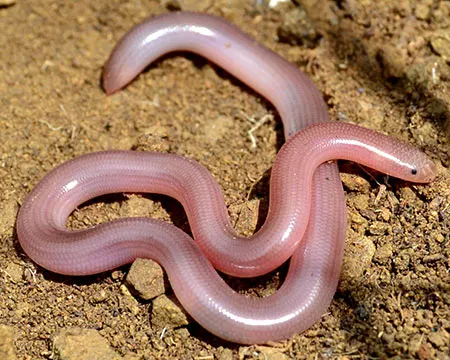
(Xerotyphlops vermicularis)
Eurasian Blind Snake
Сліпун червоподібний
It ranges from the Balkan Peninsula, the Aegean Islands, and Cyprus to Afghanistan. It prefers foothills and mountains with xerophytic vegetation, where it inhabits open areas at elevations up to 2,000 m.
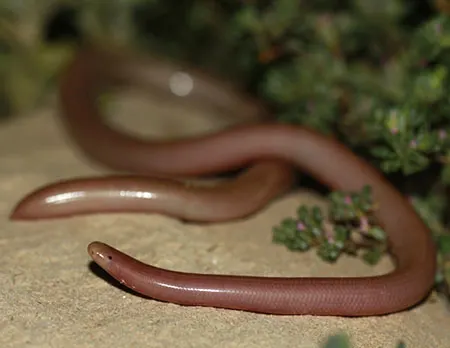
(Xerotyphlops wilsoni)
Iranian Worm Snake
Сліпун іранський
It is endemic to Iran and is known only from its type locality in Khuzestan Province.
The genus (Xerotyphlops) also includes: (Xerotyphlops etheridgei), Lorestan Blind Snake (Xerotyphlops luristanicus).
